



















Shield your laptop screens from prying eyes while experiencing best-in-class brightness and exceptional clarity.
Shield your screens from prying eyes while experiencing best-in-class brightness and exceptional clarity. 3M™ Bright
Shield your screens from prying eyes while experiencing best-in-class brightness and exceptional clarity. 3M™ Bright Screen Privacy Filters utilise nanolouver technology to help you deter visual hackers while enabling up to 85% light transmission for the intended user. This makes them approximately 25% brighter than competing privacy screens.
Contact you IT Equipment provider and have them ask about our Government and Public sector supported pricing.
Screen Privacy Filters utilise nanolouver technology to help you deter visual hackers while enabling up to 85% light transmission for the intended user. This makes them approximately 25% brighter than competing privacy screens.
3M™ Bright Screen Privacy Filters utilise nanolouver technology to help you deter “Visual Hackers” while enabling up to 85% light transmission for the intended user. This makes them around 25% brighter than competing privacy screens.



Let Certes IT Service Solutions be your trusted navigator on this exciting journey. Specialists in delivering digital transformation projects within the public sector, we have a range of solutions that can be tailored to your organisation.



We



























Up to 240 minutes fire protection for all types of cladding systems


FIREPROOF COATINGS

for wood, metal, wallpaper, plaster, concrete, fabrics & artificial foliage

Kits, seals and accessories to upgrade existing doors to fire rated doors
For cables, pipes, services, lights, ECUs, trunking & sockets

Fireproof ventilation protection for both internal and external purposes

VENTILATION
ELECTRICAL

Protection against fire, smoke, noise, pollution, weather & draught systems


INSULATED PANEL CONSTRUCTION SYSTEM WITH BUILT-IN PROTECTION FROM FIRE & FLOOD
• A low waste, low water-consumption method of construction
• Protected from flood damage by unique metal sub-frame
• Completely fire resistant
• Thermally tested by BBA
• Speedy construction
• Low air permeability
• Houses, bungalows & temporary accommodation units


Chancellor Jeremy Hunt announced in the ‘Budget for Long Term Growth’ that, among a variety of other plans, the government will abolish the furnished holiday lettings regime.
Multiple Dwellings Relief will be abolished from June after showing no evidence of promoting investment in the private rented sector.
As well as this, the Furnished Holiday Lettings tax regime will be abolished from April 2025, in the hopes of making it easier for local people to find a home in their community.
Roger Mortlock, chief executive of The Countryside Charity (CPRE) said “Air-BnB-style short-term lets have led to ghost towns and villages in some parts of the country, driving people out of the communities that depend on them.”
He added that the government’s plan to scrap tax breaks for short-term lets is a “step in the right direction.”
Another announcement from the chancellor is that the Household Support Fund will be extended until September 2024.
The Fund allows the most vulnerable families to receive targeted support for essential food and energy costs.
The government said they will also abolish the £90 fee for Debt Relief Orders so households struggling with problem debts can get the help they need, and extending the maximum period for Universal Credit budgeting advances from 12 to 24 months.
NHS projects will receive a £2.5 billion day-today funding boost for 2024/25 and £3.4 billion in capital investment over the forecast period...




£90 million of investment from the government aims to support Blackpool as part of the Levelling Up and Regeneration Act.
The government said they hope to create high quality homes to help regenerate the town centre.
The residents of inner Blackpool are set to see the creation of new “well-designed” homes and neighbourhoods, as part of a wider aim to transform local communities.
Peter Denton, chief executive of Homes England, said the investment signals “Levelling Up in action, indeed social equity, accelerating the regeneration of housing in inner Blackpool as part of a much wider mission to transform local communities and catalyse vital positive change in some of the town’s most deprived areas.”
Homes England’s Brownfield Infrastructure Land (BIL) Fund programme will kick off regeneration projects in some of the most deprived areas of inner Blackpool.
This is the latest in a series of government interventions since Blackpool’s regeneration partnership was announced 2022. Homes England was commissioned to work with Blackpool Council alongside the Department for Levelling Up, Housing and Communities, to develop a detailed proposal for interventions that address poor quality housing in the town’s inner wards. The housing intervention will complement the Department’s wider interventions and council’s work with other partners to boost the town’s economic growth. The £1 billion Brownfield...









The Regulator of Social Housing (RSH) has proposed new consumer standards designed to protect tenants and improve the service they receive.
The changes are part of the Social Housing Regulation Act and will come into effect from 1 April 2024.
The regulations will apply to all social landlords, including councils and housing associations.
The new standards will mean that landlords will have to make sure that tenants are safe in their homes and listen to tenants’ complaints and respond promptly to put things right.
Landlords must be accountable to tenants and treat them with fairness and respect and collect and use data effectively across a range of areas, including repairs.
RSH will be holding landlords to account by inspecting larger landlords regularly to check they are meeting the outcomes in the standards and scrutinising data about tenant satisfaction, repairs and other relevant issues.
The regulator will also continue to push landlords to protect tenants and put things right when there are problems and continue to focus on the financial viability and governance of housing associations as part of its integrated regulation.
Fiona MacGregor, chief executive of RSH, said: “Social landlords must keep tenants safe in their homes, listen to what they say and put things right when needed. We are introducing new standards to drive improvements in social housing, and we will actively inspect landlords to check they are meeting them...



Five local authorities in Wales are to receive funding from the Transforming Towns Loans (TTLs) programme to revitalise town and city centres.
The programme supports local authorities with town and city centre regeneration projects and has allocated more than £73 million since its launch in 2014.
Caerphilly, Cardiff, Swansea, Gwynedd and Wrexham local authorities will use the moment from this round to revitalise town and city centres and give vacant buildings a new lease of life.
Minister for climate change, Julie James, said: “Our Transforming Towns Loans programme allows councils to support projects that revitalise town and city centres to help create a sense of place and vibrant high streets for their communities.
“With the ambition of making communities sustainable over the long term, the programme aims to improve the quality of life, job opportunities and economic growth for the people who live and work in and around those towns.
“I am looking forward to seeing how councils provide loans to support regeneration projects and bring life back to high streets and disused and forgotten buildings at the heart of their town centres.”...


The government has announced that thanks to Project Gigabit, gigabit networks have now reached more than one million homes, businesses and public buildings with the aim to connect hardto-reach communities.
Project Gigabit is a £5 billion programme that aims to ensure hard-to-reach areas are not left behind in the national upgrade to gigabit broadband.
Funding has been invested for over a decade in the construction of ‘gigabit-capable’ networks in areas that are too difficult or expensive for broadband suppliers to reach as part of their commercial plans.
The government said these homes and businesses have been able to connect better since the first upgrade was delivered in 2012. Most of the 1 million premises are spread across hard-to-reach areas of the UK, including 68,800 in Scotland, 108,800 in Wales and 118,900 in Northern Ireland.
The majority of these premises are in areas where residents and businesses previously would have struggled to perform basic online tasks that others take for granted such as shopping or banking online.
Some of the premises benefitting from the gigabit networks include 5,300 public buildings which includes schools, libraries, and hospitals.
Project Gigabit aims to connect an additional 32,400 rural premises across Gloucestershire, West and parts of North Yorkshire.
This forms part of the UK building gigabit networks faster than any country in the EU, thanks in part to government measures to stimulate competition and bust barriers to rollout...


£4.7 billion of reallocated HS2 funding has been invested into the North and Midlands through the Local Transport Fund in an attempt to improve local connections, the Department for Transport has announced.
The government said it will target smaller cities, towns and rural areas.
The funding aims to reduce congestion, introduce better public transport, and upgrade local bus and train stations.
This investment – announced as part of Network North – will deliver long-term funding across the North and Midlands over seven years.
The Local Transport Fund will be made available from 2025 to give local authorities enough time to develop their funding plans.
Prime minister Rishi Sunak said the funding is part of a plan to “level up our country with greater transport links that people need and deliver the right long-term change for a brighter future.”
He added the Local Transport Fund will “deliver a new era of transport connectivity.”
The government said the investment will give local authorities the ability to increase the number of EV charge points, refurbish bus and rail stations, improve streets to make them more accessible, and expand mass transit systems.
The Department for Transport said they will publish advice for local councils and transport authorities to help them develop plans to improve local transport infrastructure in their areas.



According to RAC analysis of government statistics, council road maintenance in England dropped by 45 per cent in 2022/23 compared to five years ago. This amounts to 3,366 fewer miles receiving any kind of improvement work.
The figures show that 764 miles of A roads were strengthened, resurfaced or preserved in 2022/23, this is a 37 per cent decrease (458 miles) from 1,222 in 2017/2018.
For minor roads listed as B, C, and unclassified, the numbers were 3,380 in the last financial year compared to 6,288 five years before, marking a drop of 46 per cent (2,908 miles).
Only 4 per cent of the 17,853 miles of A roads maintained by councils in England were resurfaced or given life-extending preservation treatment in the last financial year.
35 per cent of the 158 roads authorities in the latest data failed to carry out any road surfacing while six-in-10 (61 per cent) did no preservation maintenance work at all.
RAC head of policy Simon Williams said: “These figures lay bare just how little resurfacing and life-extending preservation work councils have managed to carry out in the last financial year. We suspect this means road maintenance in England has reached a new low point – a sorry state of affairs considering how car-dependent the country is.
“It’s especially concerning to see that so few miles of A roads received any form of road maintenance last year when these important routes are used by millions of drivers every day. Meanwhile, our minor roads that are essential in connecting rural areas have received barely a crumb of the pie.”...


Heat pump grant applications increase: READ MORE
Funding for councils to help rough sleepers of the streets: READ MORE
Kirklees Council below RSH standards: READ MORE
Care leavers in London offered city-wide discounts: READ MORE
Social housing could add £50 billion to the economy: READ MORE
National Care Service Bill reaches second stage: READ MORE
The British Chambers of Commerce, in partnership with Aviva, is launching a new fiveyear industry programme to increase skills and capacity in Local Planning Authorities across the country.
The programme will seek to raise £3m to pay for at least 100 people to enter the planning industry to increase planning capacity, making investing in the UK quicker and easier.
Businesses of all sizes and across all sectors are being encouraged to come forward to back the programme.
The British Chambers of Commerce (BCC), with founding partner Aviva, is establishing a new five-year industry-led programme to increase skills and capacity in Local Planning Authorities (LPAs).
The programme will pay for at least 100 undergraduate and masters’ level qualifications for people entering the planning industry, and for people already working in LPAs who need to develop skills for more senior planning roles. It will pay for the learner’s training and will aim to facilitate work experience and jobs within LPAs. In return, at the end of their course of study, the learner must commit to work in a council planning role for at least two years...





 B Line 24” (60,5 cm) Full HD LCD-Monitor with integrated pop-up Webcam & USB-C 243B9H
B Line 24” (60,5 cm) Full HD LCD-Monitor with integrated pop-up Webcam & USB-C 243B9H
NEW Mini LED monitors with Thunderbolt docking





In the UK, asbestos remains a legacy issue in many public buildings, posing significant health and safety concerns. Craig Evans, chief operating officer of UKATA, presents a comprehensive guide on the removal, surveying, and consultation processes essential for asbestos management. This article, emphasises the strategic approach required for local and central government bodies to effectively address asbestos risks in their facilities management and health and safety protocols
Understanding asbestos: historical use and present risks
Asbestos was extensively used in the UK’s building industry for many years until its complete ban in 1999. Buildings built before this time have a high chance of containing asbestos containing materials (ACMs). Given its fire-resistant, insulating properties and strength to many
building products, asbestos found its way into numerous building materials from flooring materials to roofing materials and many other products in between, such as wall panels, ceiling tiles, coatings, and composite products. However, the revelation of its carcinogenic nature led to a re-evaluation of its use. Asbestos exposure can lead to severe health issues like mesothelioma, E



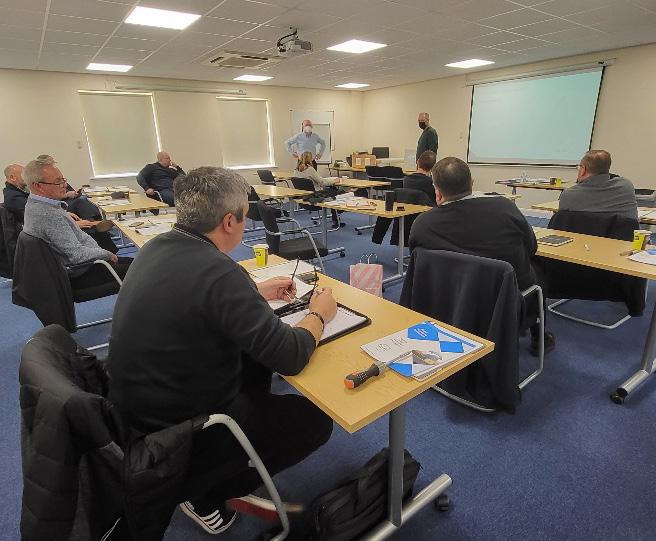




F lung cancer, and asbestosis, making its management a public health priority. The main individuals at risk previously were the traditional asbestos injuries manufacturing and installing, however over the past 25 years, the focus has changed to the construction and maintenance trades who may inadvertently come across asbestos during their day-to-day work, this focus continues to evolve to include employees and also partners of those exposed to asbestos.
The UK’s Control of Asbestos Regulations 2012 provides the legal framework for managing asbestos
Asbestos surveys are the foundation in managing the risks associated with ACMs in government facilities. These surveys provide crucial data on the location, condition, and type of asbestos present, guiding subsequent removal or management decisions. They are particularly vital in older buildings, where the likelihood of asbestos use is higher, however any building constructed before the year 2000 may have some ACMs. UKATA advocates for regular and thorough surveys, including a regular re-inspection programme, especially before any refurbishment or demolition activities, to avoid inadvertent asbestos disturbance and the associated health risks. Within the UK there are two main surveys that buildings owners can opt for. The management survey, which is the most common to identify ACMs and the risk and provides data to manage the risks, and the refurbishment and demolition survey which needs to be undertaken prior to building refurbishment works, demolition and more intrusive maintenance activities. E


Advancements in technology have introduced new methods to assist building managers
F Asbestos removal: procedures and challenges
Removing asbestos from public buildings is a complex and high-risk task. It demands skilled professionals who can navigate the intricacies of safe asbestos removal and disposal. For government entities, selecting the right contractor is crucial. This involves ensuring that the contractor is competent or licensed (for high-risk asbestos removal), adheres to the Health and Safety Executive (HSE) guidelines, and follows strict safety protocols. The UK has for 40 years had a permissioning regime that restricts those not proven to be competent to work on asbestos, this ensures that work carried out on ACMs is controlled and undertaken to a very safe and high standard, preventing exposure to asbestos. This process is not just about removing a hazardous material; it is also about safeguarding the health of workers and the public.
The significance of consultation and stakeholder engagement
Effective asbestos management extends beyond physical removal. It includes a comprehensive consultation process involving various stakeholders, including building users, employees, and the general public. This engagement is vital for raising awareness, addressing concerns, and ensuring transparency in how asbestos risks are managed.
Policy and regulatory framework
The UK’s Control of Asbestos Regulations 2012 provides the legal framework for managing asbestos and the risk posed from asbestos. It outlines the duties of building owners and managers, especially in non-domestic premises, to identify if their building/s contain asbestos and assess and manage subsequent asbestos risks. Local and central government bodies must align their asbestos management strategies with these regulations, ensuring compliance and setting a standard for responsible building management.
Training and education: UKATA’s role UKATA, through its network of approved training providers, plays a pivotal role in educating and training professionals in asbestos management. UKATA courses and certifications are crucial for building a skilled workforce capable of handling asbestos-related challenges effectively. Government bodies must prioritise training for their staff, especially those involved in facilities management and health and safety, to foster a culture of awareness and compliance.
Asbestos management plans: a proactive approach
Developing and implementing an asbestos management plan is essential for any public sector entity. This plan should detail the procedures for surveying (identify), risk assessment (assess), and action plans (control)

in case asbestos is found or disturbed. Regular updates and reviews of the plan are necessary to address any changes in building usage or structure.
Advancements in technology have introduced new methods to assist building managers and duty holders managing asbestos, making it quicker, easier, and more accessible

As we move forward, the challenges of managing asbestos in an aging building stock will continue to evolve
to ensure communication of the risk are shared to those who potentially could be at risk. These innovations range from on-site collection of data using real-time data transfer to sophisticated data management systems and asset registers that track asbestos across multiple buildings. Government bodies should leverage these technologies to enhance their asbestos management strategies.
Awareness campaigns are vital in educating the public about asbestos risks. Government agencies can collaborate with organisations like UKATA to disseminate information and foster a community-wide understanding of asbestosrelated hazards. This is especially important for residents in government housing and users of public facilities.
As we move forward, the challenges of managing asbestos in an aging building stock will continue to evolve. The government’s commitment to net zero targets and sustainable development presents an opportunity to integrate asbestos management into broader environmental and health initiatives. This holistic approach can ensure that asbestos removal aligns with energy efficiency upgrades and sustainable building practices.
Asbestos management is a multifaceted challenge requiring collaboration, expertise, and a proactive stance from government bodies. By embracing comprehensive surveying, removal, and consultation processes, and adhering to regulatory frameworks, local and central government can effectively mitigate asbestos risks. This commitment not only ensures compliance but also demonstrates a dedication to safeguarding public health and the integrity of public buildings. M
FURTHER INFORMATION
www.ukata.org.uk
Damp and mould in social housing is a pressing issue that can cause problems for the health, well-being, and quality of life of residents.
In this Q&A, David Bly, managing director of Cornerstone Management Services Ltd looks at some of the causes of and solutions for damp and mould
Causes
The problem of damp and mould in social housing has been highlighted since the death of Awaab Ishak in 2020 and new legislation
David Bly explained some of the causes of damp and mould: “Of initial importance is the recognition that damp and mould are two separate issues and, that they are ‘symptoms’

or clothing for example is only atmosphericrelated with available nutrients on the surfaces upheld by prevailing conditions.”
When treating damp and mould, one of the main goals is to improve the health and wellbeing of residents. It is well known that they can cause serious and ongoing health problems, as David Bly points out: “Spores are in the air all the time, both internally and externally, with our bodies acclimatising to their everyday availability over time. However, there is no safe level of atmospheric mould spores and it is due in the main to how our individual metabolisms vary from one person to the next. With this in mind, a key understanding would be to recognise we are all at risk where mould is evident due to the significant number of spores being release where outbreaks have occurred.”
As previously mentioned, it’s important to treat the root causes of damp and mould, not just the symptoms. David Bly said:
“With proven data indicating the majority of damp and mould-related issues are due to atmospheric management and, a recognition that many mould types require a number of days to develop, a change in atmospheric conditions is a key activity that serves to ‘break the cycle’. Damp-related issues could well be structural and as such should be investigated and repaired accordingly.
“During the UK winter period, the external atmosphere can be drier and as such, allowing it to enter a property through a cross-flow will serve to remove the warm moist internal air and, drier air tends to require less energy to reheat.
He continued: “Where mould has developed, its removal is fundamental in reducing the potential for increased airborne spores circulating the building. Mould has a root system (mycelium) and it is noted bleach and soap & water do not remove this aspect. The do indeed remove the visual fruiting elements however, with no change to the atmospheric management, the time to reproduce is greatly reduced. Using a reputable fungicide or biocide in accordance with manufacturers guidelines serves to deal with the root system as well as upholding an effective remediation process.”
Damp and mould can cause serious problems, but once identified, it is easily
 David Bly CSDB, Dewpoint, BDMA, AMCABE Managing director, Cornerstone Management Services Ltd
David Bly CSDB, Dewpoint, BDMA, AMCABE Managing director, Cornerstone Management Services Ltd
David Bly has been involved with the property damage management industry sector for the last 20 years with field-based experience aligned to the creation and production of unique reporting systems that serve to uphold professionalism and transparency of root-cause data interpretation for the industries Cornerstone serve. His experience aligns to the understanding of moisture behaviour in buildings including damp, condensation and mould-related issues, combining all industry-approved surveying techniques to deliver a bespoke service clients demand.
treatable and the products and services are there to be able to achieve this. M FURTHER
www.cornerstone-ltd.co.uk
info@cornerstone-ltd.co.uk
0345 846 0955

Building on the broad benefits of its widely specified Multiboard, insulation manufacturer Marmox introduced in January a highly versatile Fireboard into its range for both internal and external wall insulation (IWI/EWI) applications

The Marmox stone-wool-based product shares the unique Marmox honeycomb surface structure with its XPS forerunner, Multiboard, to create an A1 non-combustible, certified render-backer which is weatherproof. It can further be used internally across walls or ceilings to take a plaster finish, while providing sound absorption properties, as well as thermal insulation.
The 600 x 1200mm Fireboards are available in thicknesses including 20mm, 50mm and 100 mm and with the polymer-modified mortar honeycomb coating applied to both faces. With a nominal density of 150 kg/m3 the boards’ core material offers a compressive strength of 90 tonnes/m 2. The 20mm Fibreboard is ideally suited for external window and door reveals, ready for rendering.
The marketing manager for Marmox, Grant Terry, commented: “The introduction of Fireboard into our range significantly enhances our offer to the construction industry, meaning we have an A1 non-combustible backer board for internal or external use, which can safely be installed across masonry as well as timber or steel framing systems.
The stone wool boards are made of formed molten rock, meaning it is impossible for the fibres to absorb moisture, so they will not degrade, no matter what weather they are
exposed to. The thermal conductivity of 0.037 W/mK delivers very good thermal insulation, while the tiny air pockets within the microfibre structure of the stone wool serves to interrupt the pathway for sound transmission, which solid materials facilitate. We expect Fireboard to find applications in new-build and refurbishment work within residential, commercial and other sectors.
As detailed in a newly available A5 technical brochure which can be downloaded, Marmox Fireboard has been tested to prove compliance with BS EN 1182, EN 1716 and EN13823 (Resistance to fire test) conducted by UKTC, along with other testing completed by the BRE.
Indeed, the British manufacturer is proud to announce on its website that: “Marmox Fireboard is a powerhouse solution, designed to tackle fire hazards, intrusive noise, and the biting cold, all in one lightweight, easy-to-handle board.” Marmox is currently consulting with its established distributors to identify the ideal specialist stockists for its new fire - resistant insulation, while enquiries will meanwhile either be supplied directly from the manufacturer, or via merchants on an individual basis. M
sales@marmox.co.uk
www.marmox.co.uk


Ensuring the life safety of a building’s occupants (whether domestic or non-domestic) is the basic principle of a credible fire risk assessment (FRA). Thus, for assessors of fire risk, the level of trust imparted to them by building owners and responsible persons cannot be overstated. Despite this, we have seen how the evolving legal requirements of FRAs have exposed variations in working practices across the industry. For instance, one responsible person might simply hire an assessor to complete a tick box exercise, while another might be seeking guidance on how to elevate the safety of their premises beyond statutory standards.
Those taking up the profession are likely to be exposed to a multitude of scenarios and clients that challenge their abilities. Ultimately, a career in fire risk consulting requires a clear understanding of the building regulations and an aptitude to adapt according to the category of building, its purpose and use for occupants, and any other relevant information that could be used to determine the level of fire risk present.
Zoe Giles, a fire risk consultant for the FPA, has been working in the industry for over five years. She is registered on the Tiered Fire Risk Assessor Register at Tier 3, otherwise identified as the National Accredited Fire Risk Assessors Register (NAFRAR).
She discusses the fundamentals of FRAs, her own career path as a fire risk assessor, and the challenges assessors can face when it comes to surveying commercial buildings.
How do fire risk assessments vary depending on the type of building being assessed? For example, commercial-use buildings such as hospitals, hotels, and offices
ZG: Fire risk assessments will vary depending on the risk of life to the building users. This is demonstrated in fire safety guidance documents, such as BS 9999, which break down the risk profiles of buildings based on occupants being familiar or unfamiliar with the building, whether they are awake or alert, or whether they are receiving medical care. E



F When considering life safety, hospitals are classified as higher-risk premises based on the fact that patients may be of very high dependency, asleep, or unfamiliar with the premises, increasing the level of assistance required during an evacuation and the level of staff training required to do this efficiently. This, accompanied by the fire risk of the premises given the nature of the building and the likelihood of dangerous substances such as medical gases, will require a competent risk assessor to complete an informative, suitable, and sufficient fire risk assessment and understand the requirements as set out in the relevant fire safety guidance. For instance, HTM 05-02 (a Health Technical Memorandum that provides information on fire safety in the design of new healthcare buildings and extensions) tends to implement higher standards of fire safety, and therefore, there are many additional factors to consider. The management plan for the premises is critical for the evacuation strategy to be effective and for the risk to life to be managed as best as is reasonably practicable.
On the opposing end of the scale, smaller risk buildings will be determined by those that are occupied by persons who are awake and familiar with their surroundings, such as offices. Thus, life safety risks can vary greatly – the more complex the building, the more fire hazards, risks, and control measures will need to be considered.
The more complex the building, the more fire hazards, risks, and control measures will need to be considered
What types of things do contractors or manufacturers tend to miss when it comes to fire safety in commercial buildings?
ZG: The holistic view of fire safety in commercial buildings is often missed when construction or other types of refurbishment works are being completed. I’ve personally attended premises undergoing invasive refurbishments and witnessed some concerning practices being implemented during the construction phase. These include uncontrolled hot works near significant volumes of combustible fire load, poor standards of housekeeping obstructing the functioning of fire protection systems which are critical for maintaining tenable conditions, and poor management processes forgetting to reinstate systems, such as isolated automatic fire detectors. The most common – and I’m sure many other risk assessors can agree – is the wedging open of fire doorsets protecting escape routes!
What are the most common reasons a fire risk assessment might raise issues of concern?
ZG: There are many common concerns a fire risk assessment may address, some of which I have already referenced. The most important ones often revolve around the actual management of the building. You may have a building that has been constructed according to modern-day standards and that is fully compliant with the Building Regulations. However, bad management practices can have a detrimental effect on the life safety risk of the building as well as business continuity. For example, poor standards of housekeeping in escape routes may prevent them from being accessible in an emergency or heighten the risk of a fire originating if items are stored in close proximity to ignition sources. Poor management of fire doors such as wedging them open will render them ineffective at restricting fire growth. Similarly, not reviewing invasive work to the building structure such as where new cables are installed may also have a detrimental effect on the rapid spread of smoke and fire throughout the building. E
Fireco offers a range of compliant hold-open devices for fire doors, suitable for any environment, with Site Manager remote monitoring.


Freedor Pro takes the weight out of heavy fire doors, allowing you to keep them placed open easily with its free-swing feature. Activated via radio signal to close all doors, it prevents the spread of smoke and fire.
Expandable system: add new Pro units anytime.
Improves access for those with mobility issues
Ideal for all areas, like corridors, kitchens and stairs


DorMag Pro is a wireless fire door magnet that holds fire doors open legally, auto-disengaging on alarm. As it’s radioactivated, it’s ideal for noisy environments.
Activates to fire and fault as part of a critical system
View live status with remote monitoring software
Durable device with flexible fitting options
Freedor Pro DorMag Pro

This should be more than a tick box exercise for the company
F I would also like to highlight that, more recently, we have seen an emergence in the use of eco-friendly and cost-effective means of transport such as e-bikes or scooters, which has resulted in an increased number of lithiumion battery fires. Many of these could have been avoided if the charging of such batteries was well managed. Many of the issues I’ve mentioned can easily be combatted by regular fire safety training for staff. This should be more than a tick box exercise for the company, particularly in those buildings where there is a higher risk to life and, admittedly, there is a lot more to lose based on the reliance on staff to instigate a complex evacuation strategy, such as progressive horizontal evacuations.
How are special considerations or evacuation strategies for workers with disabilities or mobility issues currently being met in commercial buildings?
ZG: Over the years, the introduction of legislation and subsequent guidance documents has changed the picture, with increased consideration given to disabled evacuation as part of the original building design. These buildings are generally designed with an idea of the end service user in mind, and they will be designed based on the intended evacuation strategy for the premises. For example, a progressive horizontal evacuation will likely be adopted for buildings accommodating large numbers of disabled or mobility-impaired occupants (such as care homes or hospitals), as there will not be a high enough staff-to-occupant ratio to assist an evacuation simultaneously, plus some occupants may be particularly vulnerable and
should only leave the building as a last resort (such as those in an operating theatre). In order for this to be utilised effectively, there must be a high standard of internal compartmentation, fire detection and alarm systems, staff training, and more. The responsible person will have to give special consideration to any staff members employed to work on the premises with disabilities; cooperation and coordination are required to ensure the individual can be safely evacuated from the premises without reliance on the fire and rescue service. This can be achieved with the provision of evacuation aids such as evacuation chairs, safe refuge waiting areas, management through buddy systems, and more.
Can you describe a typical working interaction between a fire risk assessor and a building owner/ manager?
ZG: The fire risk assessor will likely be appointed by the building owner/manager as the ‘competent’ person to assist them with fulfilling the legislative requirements of the Regulatory Reform (Fire Safety) Order 2005. It is the fire risk assessor’s duty to ensure the responsible person has a full understanding of the duty imposed on them under the legislation and will provide advice on how to maintain a good standard of fire safety within the premises. There may be actions needed as a result of the fire risk assessment, which will require phased planning based on the financial demand. Communication is key and suitable interim measures may need to be discussed to help maintain a reasonable level of fire safety until the project can be completed. E

F How have the latest amendments to the Fire Safety (England) Regulations 2022 impacted the role of fire risk assessors specialising in commercial buildings (if at all)?
ZG: The amendments apply to high-rise residential buildings and do not directly address commercial buildings. However, it should certainly be a discussion point, and consideration should be given to the items addressed in the amendment, especially in terms of communication with the fire and rescue service to assist them when planning and responding to an incident, as there are still varying degrees of risk to life safety in commercial buildings where search and rescue missions may be required. Issues with competency have been at the forefront of industry discussions in recent years.
How can assessors prevent fire risk assessments from simply becoming a tick box exercise?
ZG: It is vital that fire risk assessors avoid complacency and continue to strive to expand their knowledge and experience by exercising and demonstrating competency in their work. Over time, the ideology of a ‘suitable and sufficient’ fire risk assessment has evolved, but unfortunately, economic factors have also financially impacted the industry. In some circumstances, this has led to a reduction in the time spent on site or the time allocated for
It is vital that fire risk assessors avoid complacency and continue to strive to expand their knowledge
report writing. It is important we uphold high standards and provide good quality reports, particularly for more complex premises.
What are the benefits of higher-value fire risk assessments?
ZG: Arguably, the greatest benefit of a highervalue fire risk assessment is the fact that it demonstrates the assessor’s due diligence and competency. This will benefit the client as any potential scenarios leading to the increased risk of fire have also been considered, not just what was observed on that day. It will also help maintain confidence and trust between the risk assessor and the client.
As someone registered on the Tiered Fire Risk Assessor Register at Tier 3, this marks you out as being one of just 3 per cent of the estimated national cohort of fire risk assessors, independently accredited to undertake fire risk assessments in complex/high risk premises.
What traits do you think helped you achieve this level and are ones that a fire risk assessor should have?
ZG: Accountability – fire risk assessment is what it says on the tin – a risk assessment. Whilst fire safety documents exist and were created to help assist risk assessors, there will be buildings that, unfortunately, are hard to apply and will deviate from traditional assessment. The risk to life should be considered first and foremost, and when asking clients to invest in changes or modifications, you have to weigh up whether they are cost-effective and will provide clear benefits to life safety and property protection. It is important that whatever the decision, you take ownership of your opinions and recommendations and understand the possible repercussions. It is also important to emphasise that it is impossible to know everything in this industry, so you should equally be able to recognise your own limitations.
Approachability – this is particularly important to build up a good rapport and level of trust with the client. As I mentioned earlier, many fire risk assessments identify issues regarding the management of the building, but having a level of trust may enable you to delve deeper
and make the client feel comfortable in being transparent about any concerns they have experienced that you would otherwise not be aware of.
Ambition – it is impossible to know everything in this industry, and therefore, you should have the ambition to learn on the job through research and networking.
What do you enjoy about the role, and what challenges does it bring?
ZG: I came upon fire risk consulting by accident after shadowing colleagues at my previous company. I saw how passionate they were and began to take greater interest in reading their reports and learning more about the standards. I have faced imposter syndrome in my career, but I’ve found that the best way to overcome that is being able to back up my professional recommendations about why a client needs to implement changes through understanding the guidance documents and knowing how to advise them clearly.
I love talking to our clients confidently, and I like when we can agree on a cost-effective approach by offering them another, safer alternative. I also enjoy building a relationship with clients so they feel comfortable coming to me for advice about fire safety and value my opinion, experience, and knowledge. I like the idea that we’re trying to make buildings safer and reducing the risk to life, and really enjoy my job.
What advice would you give to other young professionals looking to join this field?
ZG: I would say believe in yourself. Do your research and shadow other assessors as much
Managing risk based on a building’s complexity and use can ensure that the best safety practices are implemented
as possible. Then, build up your confidence by going to different sites. Remember to take the time to read the standards and to learn as much as you can. It’s literally impossible to know everything, so accept your limitations. Also, if you find yourself being challenged by a client, don’t let that deter you – your professional opinion matters and you should trust your recommendations.
Finally, never give up. The FPA has been nothing but supportive of my career path, helping me with my training and much more. It can be a risk to employ someone without fire safety experience, but I’ve noticed that many more companies are open to helping people start from the bottom and work their way up.
Life safety cannot always be guaranteed in the event of a fire, but managing risk based on a building’s complexity and use can ensure that the best safety practices are implemented. Fire risk assessors are a crucial part of this process, and it is through their commitment to raising the standards of competent behaviour and being accountable in their work that better systems can be applied and more lives and buildings protected. M
Find out more about the FPA’s fire risk assessment service here.







In the event of an emergency, help evacuate people with disabilities from a refuge area via two-way radios or master control point.





Fully Wireless
Fully Monitored
EN54-4 PSU
Battery Back up

The DeafCall Pillow Alarm is a mains powered device designed to alert people who are deaf or have a hearing loss while sleeping.






Works with DeafCall Transmitter BS5839-1 EN54-4
Completely Wireless
Main Fails Alerts
Battery Back up
Signal Monitored
Strong Vibration Alert System complies with BS5446-3



Gen2 Queue is a standalone wireless fire alarm system capable of harvesting messages, offering addressable alerts, and supporting multiple buildings. Additionally, it is not reliant on any other 3rd Party Networks like LAN, WAN, GSM.








Completely Wireless and Fully Monitored
AlarmCall Pro + Interface Transmitters Designed to Meet BS5839-1 & En54-4 Standards
Fully Addressable Alarm Activations
General Faults and Critical Fault Notifications
Full Reporting Suite
Escalations to ARC, Pagers, Smart Mobiles and Two-way Radios



The Fire Safety Event will open its doors at the NEC Birmingham on 30 April – 2 May 2024 and will play host to leading manufacturers and suppliers to showcase their latest approved products and solutions. Dedicated to supporting industry practitioners, professionals and organisations in achieving and maintaining the very highest standards of fire safety management
The UK’s largest showcase of exhibitors and supporters With over 175 exhibitors participating at the show, some of the industry’s leading brands including: Apollo, Checkmate Fire, Plus+ Group, Sentry Doors, TOA and many more, will be showcasing their latest research and development, product and solution launches and live demonstrations.
A number of key association and industry bodies will be supporting the Fire Safety Event and will be on hand to offer guidance
and expert advice to visitors. These include the Association for Specialist Fire Protection, National Association of Healthcare Fire Officers, Fire Protection Association, Smoke Control Association, Institute of Fire Safety Managers, Institution of Fire Engineers, BAFE and ECA/FSA and more.
Unmissable CPD-Accredited Conference Theatres Education is at the heart of The Fire Safety Event. Boasting three industry-led theatres E
Specify Halspan Verified fire doors systems for peace of mind. Essential components have been tested together to ensure compliance. Door systems are available in many configurations for all sectors providing compliant:
Specifications
Drawings
Door Schedules
Supporting test evidence
Halspan Tracker asset management software and Halspan Inspection Services ensure responsible persons satisfy their obligations to:
BS 9999:2017 for fire Safety in the design, management, and use of buildings - Code of practice. I.6.2 Fire Doors
RIBA Plan of Work Building Safety Act 2022.
The Regulatory Reform (Fire Safety) Order 2005
BS 8644-1:2022 Digital Management of Fire Safety Information
Do






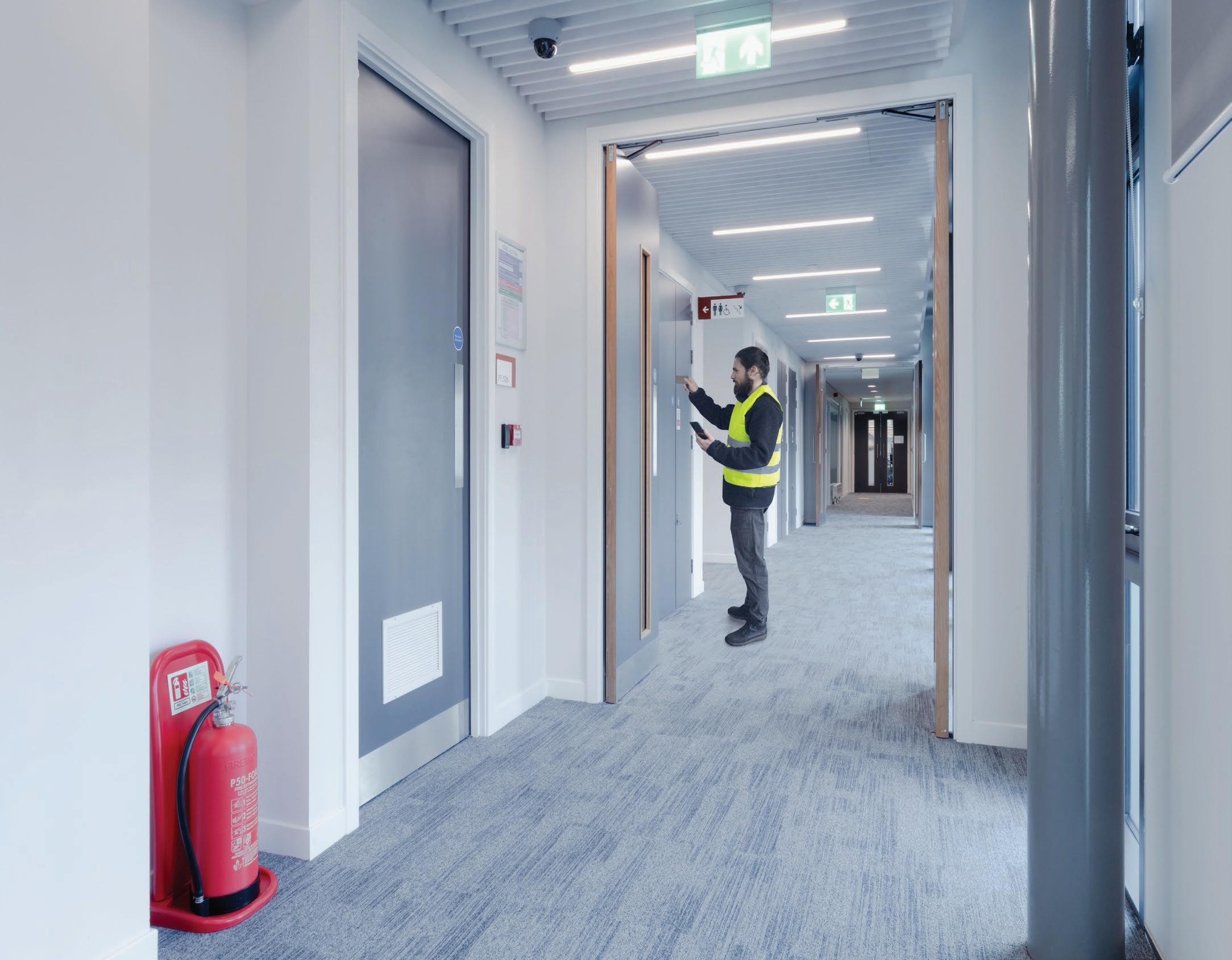



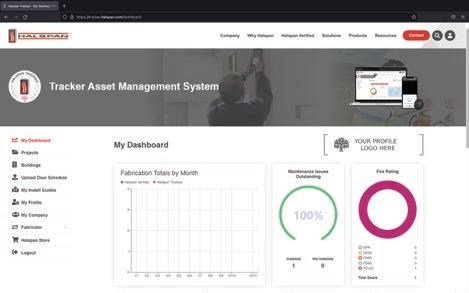
There will also be networking receptions taking place at the end of each show day
F and offering 45+ hours of free-to-attend CPD content this is the perfect opportunity for visitors to gain direct insight into improving, maintaining, and championing fire safety for all businesses.
The Passive Fire Conference is in partnership with the Association for Specialist Fire Protection (ASFP), this conference theatre will cover passive fire protection topics and various fire safety measures in the built environment. Hear from the experts and get the essential advice from specification, installation, inspection and maintenance.
The Innovation & Compliance Theatre will showcase presentations on the important industry updates and guidance for practitioners and business owners. With a focus on standards, regulations and industry best practice, these sessions will be vital to ensure businesses remain compliant and are best equipped to meet the needs of their clients.
The theatre will feature seminars on Pressurisation Systems; Passive Fire Protection; Smart Social Homes; and Building Safety.
New for 2024, The Fire Safety Leaders Summit sponsored by RiskBase will feature a line-up of leading industry experts and keynotes, get the insight and expertise on best practice, regulatory updates and topical areas impacting the fire safety sector.

The summit will cover topics such as Fire Safety Legislation and the Responsible Person; Recruiting and Retaining Staff; Residential Fire Safety and Arson.
To facilitate more networking and build new contacts, there will also be networking receptions taking place at the end of each show day. Visitors, exhibitor and partners are invited to unwind and recoup from their day in an informal setting with complimentary drinks. E






Additionally, the events offer free parking on site at the NEC
F The largest UK tradeshow dedicated to the protection of people, places and assets
The Fire Safety Event is uniquely co-located with The Security Event, The Health & Safety Event, The Workplace Event and The National Cyber Security Show, which together form The Safety and Security Series. With only one registration, delegates have access to all shows, making this one unmissable opportunity.
The Security Event will showcase the world’s leading security brands, offering visitors the chance to source the latest products, technologies and solutions, whilst networking and meeting face-to-face with key experts from across the industry. The seminar programme includes the Designing Out Crime Zone; Professional Security Officer Live; Security Leaders Summit; and The Forum.
The Health & Safety Event is the UK’s largest gathering of those responsible for running a safe and efficient workplace. With seminars, practical workshops, and exhibitors, it attracts thousands of workplace professionals from the industrial, commercial, and public sectors.
The Workplace Event is the home of workplace and facilities innovation and aims to bring visitors closer to workplace leaders. The event will offer seminars on topics that are vital for best practices and strategies to elevate the workplace environment and employee performance. The programme is specially curated for practitioners from facilities, HR,
technology, real estate, design, architecture, consultants and advisors.
The National Cyber Security Show is geared towards tackling cyber threats and protecting the digital world. The Cyber Solutions Theatre will provide enlightening case studies and expert seminars led by cyber innovators and industry-leading solution providers. The seminars will cover the fundamental aspects of cybersecurity, including security network fortification and resilience maintenance, helping attendees to acquire valuable skills, knowledge, and actionable insights on utilising technology to maximum security.
Additionally, the events offer free parking on site at the NEC. This will further enforce that the NEC is the most accessible venue for any event in the fire and security sector with a train station and airport on side and the venue adjacent to the M42 motorway. M
For more information or to register for your FREE pass visit www.firesafetyevent.com

In an ever-evolving real estate landscape, Integral and JLL are leading the way in shaping the future of real estate and building performance.
With JLL’s Strategy and Consulting services, we collaborate with clients to develop customised real estate strategies that align with their business objectives. Conducting in-depth market research, analyses data, and provides valuable insights to inform decision-making.
With JLL’s Project and Development Services, we offer comprehensive project management and development services to bring real estate visions to life. Our team handles everything from site selection to architectural design, engineering, and construction oversight.
JLL’s Facilities and Property Management team takes care of the day-to-day operations and maintenance of commercial properties. JLL’s UK engineering business, Integral provides end-to-end engineering and facilities services to ensure safe, compliant and resilient buildings.
By applying our years of technical expertise, latest tools and specialist capabilities, Integral can build and maintain sustainable and efficient environments for people and businesses to thrive.
Harnessing the power of technology and data analytics, we provide clients with market insights, predictive analytics, and performance metrics. These tools enable clients to make data-driven decisions and optimise their real estate portfolios, ensuring maximum performance.
Integral and JLL are shaping the future of real estate and building performance. Contact us today to discover how we can transform your real estate strategy.

 Mark Evans Client Solutions Director Integral
Mark Evans Client Solutions Director Integral
 Nick Freeston Head of Consulting and Public Sector JLL
Nick Freeston Head of Consulting and Public Sector JLL


GB spoke to Jeremy Smith, MD, Northern Europe at Metrics Maturity about cloud proliferation
Cloud is a hot topic in any IT or digital conversation nowadays, so we began by discussing the impact that cloud proliferation has had on government IT spending. Jeremy Smith said: “The market’s been misled for some time, by the cloud marketing machine: cloud is rarely cheaper. Benchmark data from independent, objective studies we’ve undertaken shows organisations finding cloud spend increasing by up to 200 per cent compared to previous on-premise solutions.” He cited a few reasons for increase in spend, including a lack of governance, which enables too many people to order capacity and spend control disappears. He also highlighted insufficient optimisation of cloud resources and stated that usage should be scaled up and down as appropriate and resources only utilised when required.
Inappropriate use of cloud resources such as on-demand capacity rather than reserved instances was another example given. He said: “Best-in-class cloud usage is, 40 per cent of capacity in reserved instances, whereas at the other end of the spectrum, some organisations are using none. The difference in cost of such strategies is mind-bending.”
Jeremy Smith also pointed out: “Use of software as a service (SaaS) may seem like a good idea because you no longer have to worry about managing development, capacity or application strategy, but it can have farreaching implications, especially when it comes to negotiating with providers; we’ve seen some usuary increases in licence costs recently, far in excess of already high inflation.
“Check the bills! Cloud billing is based on consumption, so check what you’re paying for on a monthly basis! It’s essential to identify and understand any runaway costs.”
We also talked about the impact of inflation on government IT spend. Jeremy Smith said: “Everybody knows what happened recently. The vast majority of service and software providers have been keen to pass on increases and they have often been higher than the rate of inflation. It’s been a good excuse to hike prices and negotiation with providers is proving almost impossible.
“When is this most noticeable? Where outsourcing contracts end and need renewing or re-tendering, the proposed pricing will, generally, be significantly higher than the old pricing; budgets need to take this into account.”

Governance structures around who can order cloud capacity should be stringent
He continued: “The question to be answered is: what’s a reasonable increase and how do you know what target pricing you should be negotiating towards? When re-tendering, unless an RFP has very specific requirements defined, you may receive proposals with different solutions from different providers and the cheapest offering may not be the best value. Under these circumstances you can benchmark the pricing of your BAFOs to assess whether the proposed pricing represents good value for money, understand where negotiation levers exist and what alternative scenarios (with lower costs) might be possible.”
Of course, all of this will have an impact at local government level, as Jeremy Smith points out: “Local government budgets are arguably tighter than they’ve ever been. In contrast, demand for additional services, new functionality and increasingly less stable and more frequently changing SaaS platforms constantly drives higher support requirements.
“Due to the tight controls on local government budgets, arguably even tighter controls need to be put in place around use of cloud services due to an inability to flex budget allocation. Also, as mentioned above, checking outsourcing pricing for competitiveness and negotiation opportunities is vital.”
He continued: “When it comes to SaaS licence spend, get those licence structures checked to make sure they’re the most appropriate version of your provider’s portfolio. Licence structures change with the wind and it can cost significantly more than necessary if you have the wrong one. Also, be mindful of the puppy-dog sale: providers will offer additional functionality and features at no cost, trying to tempt you to use them, the question you need to ask is: will that functionality and those features be free when it’s time to renew?”
Following on from this, local government needs to understand and be prepared to mitigate these changes.
Jeremy Smith pointed out: “In order to manage spend better, governance structures

Jeremy Smith has been in IT benchmarking and sourcing for over 25 years and been responsible for this region since 2007. Received benchmarking as an end user, delivered and advised on benchmarking and sourcing as project manager and been the sponsor for numerous projects at Metrics
around who can order cloud capacity should be stringent and management of capacity types employed (on-demand versus reserved instances) should be rigorous.
“As for the price shock when renewing or re-tendering outsourced services, an upfront assessment of current agreements to understand what they’re likely to cost, before going into a renewal or tender process could enable re-scoping of services to drive spend down. Also, when undertaking such an exercise, ensure no supplementary, or enhanced services are added to scope unless absolutely necessary; requiring a business case for additional services can damp down demand.” M
FURTHER INFORMATION
www.metrics.biz


Roy Sullivan, senior consultant and authorising engineer (water) at the Water Hygiene Centre Ltd investigates Legionella and RAAC

Potentially one of the biggest news stories that broke in 2023 was the one about RAAC –Reinforced Autoclaved Aeriated Concrete. This method of construction was widely used from the mid-1950s through to the early 1990s. The predicted lifespan of this type of concrete from installation to expected potential failure was 30 years, which is why this issue has recently hit the headlines.
Why was RAAC used?
The use of this type of concrete was widespread. The rationale at the time was that it was cheaper than conventional methods, it had good thermal insulation qualities, and it was lightweight. In hindsight it has come to light that often there was insufficient coverage of the steel reinforcing bars by the concrete, leaving them exposed to elements and subsequent corrosion which will inevitably weaken the structure. As a result of
these findings and ongoing investigations, many buildings identified as having RAAC have been subject to closure, a good proportion of those being schools.
Water Hygiene consequences of using RAAC
When a building is occupied and the hot and cold-water systems are in normal use as they were designed to operate, then the risk from Legionella and other waterborne pathogens remains at an acceptable level. Once these hot and cold systems become effectively redundant from lack of use due to building closures, then the potential risk increases significantly. Basic water hygiene management involves keeping the hot water, hot, the cold water, cold, and more importantly keep water moving within a system, none of which can be achieved to the level required if a building is closed and not used. As a result of closure, the building plant may be turned off; consequently, the Calorifier and associated hot water temperatures will fall below the parameters required and water can stagnate in the cold-water storage tanks and all distribution pipework within the building due to lack of use. This all creates the perfect storm for Legionella and other waterborne pathogens to proliferate within the system.
So, what can we do to keep our domestic water systems safe?
HSG 274 – Part 2 section 2.50 – 2.52 gives guidance on managing the water systems in buildings taken out of use.
“Where a building, part of a building or a water system is taken out of use (sometimes referred to as mothballing), it should be managed so that microbial growth, including Legionella in the water, is appropriately controlled.
“All mothballing procedures are a compromise between adequate control of microbial growth, the use of water for flushing (while avoiding waste), and degradation of the system by any disinfectant added.
“Where disinfectants are used, these should leave the system fit for its intended purpose. In general, systems are normally left filled with water for mothballing and not drained down as moisture will remain within the system enabling biofilm to develop where there are pockets of water or high humidity. The water in the system also helps to avoid other problems associated with systems drying out, including failure of tank joints and corrosion in metal pipework. The systems should be recommissioned as though they were new (i.e. thoroughly flushed, cleaned, and disinfected) before being returned to use. E
Basic water hygiene management involves keeping the hot water, hot, the cold water, cold


Having read the above guidance, the potential risks posed by a water system in an unoccupied building can be easily managed if a calculated and pragmatic approach is taken. Ideally, the system should be left in a live condition if the likelihood of reoccupation is high following rectification works.
That is to say, nothing is drained down and the heat source for hot water generation is left on so that hot water temperatures can be maintained. There is a need to identify if there are any hot and cold water services within the areas that are closed, so appropriate measures can be taken.
If the building is unlikely to be reoccupied for an extensive period, then a decision may be made as to different approaches as outlined in the above extract from HSG274 – Part 2 each on its own merits.
The easiest and least intrusive solution is to implement a Legionella flushing regime on all domestic water system outlets, until the outlet temperature is comparable to the supply temperature, as, in their current unused state

We all have a duty of care to our work colleagues, the public and ourselves
they are effectively deadlegs. This process should be documented, and the records held within the site logbook. Legionella samples may also be taken for laboratory analysis (if not already part of your current regime) to confirm that your flushing regime is still effective.
Several schools and other organisations affected by building closures due to RAAC have sought to use temporary offices or Portacabintype structures as alternative workspaces and welfare facilities so that they can continue to function as close to normality as possible.
It’s also worth noting domestic water systems within these temporary structures will also require careful management before they are occupied and will also require a Legionella risk assessment
HSG274 – Part 2 – Sections 2.40 – 2.43 gives guidance on the commissioning requirements before bringing a new system into operation.
The Health & Safety at Work Act 1974 states: “Section 4 places a duty on anyone responsible for the workplace to ensure that the premises, plant, and machinery do not endanger the people using them”.
We all have a duty of care to our work colleagues, the public and ourselves. The likelihood of an incident derived from the water systems which have been left unmanaged in an unoccupied building can be reduced dramatically to levels that are deemed acceptable or ALARP – as low as reasonably practicable - with a relatively simple regime which prevents the conditions favourable for the growth of Legionella and other waterborne pathogens. M
FURTHER INFORMATION
www.waterhygienecentre.com
Legionella
The organisers of the world’s largest dedicated hydrogen event, World Hydrogen 2024 Summit & Exhibition have announced its return to Rotterdam in May 2024, with a whole extra summit day added. Sustainable Energy Council (SEC) are partnering with the Government of the Netherlands, the Province of Zuid-Holland, the City of Rotterdam, and the Port of Rotterdam to host an extended, larger scale Summit in 2024, to expand the event to meet the surging demand.
This event is now in its 5th edition, part of the SEC World Hydrogen Series. The Official World Hydrogen Summit & Exhibition in Rotterdam is sponsored by a variety of leading hydrogen companies and stakeholders in the energy sector, including Smart Energy, Air Products, bp, CEPSA, Linde. For more information, visit the website here.
With the hydrogen market rapidly accelerating in the world, the need for this summit and exhibition is ever-growing to provide a useful, informative platform for energy professionals across the globe. The priority for the EU is to develop renewable hydrogen with aims to produce 10 million tonnes
by 2030, organisations and stakeholders require shared knowledge to help contribute towards this end climate goal. Download the brochure to see what industry topics will be covered and what can be expected from the key event in the industry calendar.
Following the sell-out of Word Hydrogen 2023, the organisers have extended the event to three days due to demand and popularity. Visitors are invited to register for free providing them access to the largest hydrogen exhibition in Europe, which has increased to five exhibition floors, allowing over 500 global energy leaders and stakeholders to exhibit and network with visitors to the event. Among these new features announced for 2024, attendees also have the opportunity to attend two H2 Tech Series stages on the exhibition floor for insightful, short discussions on top energy themes. These brand-new stages, H2 Tech Innovation and H2 Tech Insights allow attendees an opportunity to hear from hydrogen experts, access a wide range of hydrogen research, demonstrations, and analysis all on the exhibition floor!
If attending to represent your company and network to build industry contacts, delegate passes allow for attendees to access all areas, including the C-Suite summit with over 350 global hydrogen speakers. Delegates are also invited to go on exclusive site visits to the local port facilities and infrastructure to explore where the latest hydrogen projects are being developed – a truly unique experience. An exclusive feature of the event which allows it to stand out in an ever-growing market is The Africa Hydrogen Forum on the 14th May. Co-hosted with the African Hydrogen Partnership, it aims to highlight the E







F vast commercial opportunities to develop a hydrogen economy in Africa and the partnership potential this creates for Europe and the rest of the world in enhancing energy security and sustainability – as a forum within the main summit area, this is always a very popular feature and spaces are limited. Find out more and register here to avoid disappointment.
Hear from previous event attendees below:
“This is a fantastic event with lots of people who come from lots of different countries, with different expertise” - H.E. Rachmat Kaimuddin, deputy minister for infrastructure and transportation coordination, Coordinating Ministry of Maritime Affairs, and Investment of the Republic of Indonesia. “There is so much interest and so many people, there’s strong contributions on the panels and during the summit. The exhibition is a hive of activity and there’s an appetite for people to collaborate on hydrogen and have the right conversations” – Dr Fiona Simon, CEO, Australian Hydrogen Council.
“I’m excited to have been invited again to the World Hydrogen Summit because hydrogen rocks. If we want nature really to be restored, we have to drastically reduce the emissions of CO2 and the only way we can do that is to have a rapid transition of our energy sector into renewable energy.” – Frans Timmermans, executive vice-president, European Commission
The Sustainable Energy Council is on a mission to accelerate a hydrogen-powered energy transition. Hydrogen will be crucial to ensure a decarbonised energy future and SEC are committed to the development of a hydrogen economy. They play a key role by gathering public and private sector stakeholders at our global summits to collaborate and sign partnerships for ambitious hydrogen projects that will significantly contribute to reaching net-zero goals. M FURTHER INFORMATION
www.world-hydrogen-summit.com

From 2025 to 2028, £1bn will be made available to public sector bodies through the Public Sector Decarbonisation Scheme (PSDS) to decarbonise the public estate

Accessing these funds has become increasingly challenging over the past five years due to inflation and heightened awareness, with a notable 72 per cent surge in grant applications between the last two rounds alone. This trend is only set to continue, and the quality of applications will become ever more crucial for success.
The scheme, managed by Salix on behalf of DESNZ, supports reducing energy consumption through a fabric-first approach and then decarbonising the heat delivered to the building by installing a heat pump. The grant value is dictated by the CO2 that is offset over the new system’s lifetime. Crucially, the carbon associated with the electricity used by the new system is ignored. This means that a low-efficiency system is eligible for as much money as a high-efficiency system.
Generally, few people know what a heat pump is and even fewer know what impacts heat pump efficiency - also known as Seasonal Coefficient Of Performance (SCOP). SCOP is an annual measure of how much heat is delivered for each unit of electricity consumed. Unlike boiler efficiency, SCOP varies significantly based on operating conditions, with some systems achieving global SCOPs exceeding 5.0, while others fall as low as
0.5. Versus a gas boiler, the former may see a heating bill reduction of 40 per cent whilst the latter could see an increase of 470 per cent.
Two methods for improving SCOP are lowering the heating system temperature and selecting a Ground Source Heat Pump instead of an Air Source Heat Pump, which have a higher installation cost but are eligible for more grant funding. Nevertheless, theorised efficiency may not always be realised; improper controls being one of the most common obstacles to efficiency.
For Salix, contractors, and consultants, SCOP matters, but not to the same magnitude as it does for the organisation that is left paying the bill. In their eagerness for a successful PSDS application, organisations may opt for the first or cheapest installation that is recommended to them. Not only may this not hold up to the scrutiny of Salix’s technical assessment, but even if funding is awarded, a system that costs five times as much to run cannot be considered a success. Read full article here. L
www.geoenergy.co.uk/news/psdsuccess


Olivia Smalley, head of policy and communications at the Heat Pump Association, reflects on the pivotal role that local government and officials will play in the transition to low-carbon heating such as heat pumps
Heat pumps are at the forefront of the transition to net zero, offering an efficient and environmentally friendly alternative to traditional heating systems such as gas, oil or LPG boilers. This article provides an overview of the current UK government policy to support heat pump deployment, available funding, the benefits of heat pumps, and a forward-looking perspective on the role heat pumps will play in the future.
How does a heat pump work?
A heat pump is a system for heating any building. It works by extracting ambient heat from outside to heat the inside of the property. Here is a quick overview of how they work.
Firstly, heat energy is extracted from the air, the ground or water. Even in cold weather, there is still warmth stored in the air or ground outside your home. This heat energy then passes over a ‘heat exchanger,’ known as an E
The UK’s longest-established renewable energy company joins DECODE CORBY to help decarbonise the local manufacturing industry

Marlec Engineering, an award-winning renewable energy product manufacturer for over 45 years, provides clean energy solutions to power infrastructure that normally relies on gridconnected energy or fossil fuel generators, such as street lighting, signage, IOT, rail crossings and environmental monitoring. Marlec’s offgrid power systems are used worldwide by the railways, highways, telecoms, utilities, and leisure sectors. In 2024, they will be a part of the DECODE CORBY project that plans to decarbonise the local manufacturing industry in North Northamptonshire.
DECODE CORBY is a 12-month project led by Electic Places, in partnership with Tata Steel, North Northamptonshire Council, and other stakeholders, to develop and implement a decarbonisation plan for the local industries. Innovate UK, the UK’s innovation agency, will fund the project and connect businesses to achieve the goal of helping industries and manufacturers reduce their emissions and avoid carbon leakage. By creating a peer-reviewed evidence base and sharing best practices and lessons learned, the project will have a national impact and contribute to the UK’s net-zero target.
Their first objective is to create a new organisational body fostering collaboration among key stakeholders, including manufacturers, low-carbon technology and platform developers, distribution network operators (DNOs), local communities and the local authority.
They will then aim to disseminate the evidence base developed through the UK Community Renewal Fund supported project North Northamptonshire to Net Zero Project on current emissions in the local area. They will gather existing decarbonisation plans, such as Tata’s extensive decarbonisation and scope 3 supply chain insetting programmes. The next objective will be to act as the coordinator and project manager for blending existing plans, and measuring their impact and reach for net zero. They will then leverage their digital twin to ‘optioneer’ different strategies and find the best economic/environmental/social solutions, including overcoming grid constraints. Enabling them to recommend and agree a credible strategic decarbonisation plan to close the net zero gap aligned to existing industrial members industries and their capabilities. Finally, where there is a gap in capabilities, they will then plan how to build the necessary skills (e.g. legal/technical) to enable long-term implementation beyond the funding period.
How will Marlec Engineering help?
Marlec is an example of how implementing the correct eco measures can dramatically reduce a business’s carbon footprint. Marlec will share its expertise and experience in providing renewable solutions to support the project partners in developing and implementing the decarbonisation plan. L
FURTHER INFORMATION
www.marlec.co.uk

To support the deployment of heat pumps, the UK Government has introduced several funding mechanisms
F evaporator, inside the heat pump to warm up a refrigerant liquid. As it warms up, the refrigerant liquid evaporates and turns into a gas.
The refrigerant gas then moves into a compressor which increases the pressure of the gas and makes the temperature rise.
This hot refrigerant then passes over another heat exchanger, known as the condenser, and returns to a liquid. In doing so, it transfers its heat energy to warm up water used in your radiators and hot water tank.
The pressure of the refrigerant liquid then reduces, and it passes back to the evaporator to restart the process.
Of course, the above description is simplified. If you want to learn more about the mechanics, read our homeowner guide .
The UK Government has recognised the critical role that heat pumps will play in achieving our ambitious climate targets, including reaching our legal target of net-zero carbon emissions by 2050. In alignment with the Ten Point Plan for a Green Industrial Revolution, the government has pledged to significantly increase the adoption of heat pumps. This commitment is further underscored by the Heat and Buildings Strategy , which outlines plans to install 600,000

heat pumps per year by 2028. The strategy emphasises the need for a gradual phaseout of gas boilers, making heat pumps a vital component of the UK’s decarbonisation efforts.
To support the deployment of heat pumps, the UK Government has introduced several funding mechanisms. The Boiler Upgrade Scheme (BUS), launched in April 2022, offers grants of up to £7,500 to homeowners in England and Wales to help cover the cost of installing air source and ground source heat pumps. This scheme is a critical step in making heat pump technology more accessible and affordable to a broader segment of the population.
Moreover, other schemes are available such as the Home Upgrade Grant and Local Authority E






The journey towards widespread heat pump adoption is not without its challenges

F Delivery scheme which fund energy efficiency measures in homes of low income, off-grid and EPC below D. Other schemes include the Energy Company Obligation and the Public Sector Decarbonisation scheme. The Local Authority Delivery scheme has funded 3,074 heat pump installations since the start of the scheme.
The Public Sector Decarbonisation scheme is a scheme open to public sector bodies in England, including central government departments and non-departmental public bodies, the NHS, schools, emergency services, further education, and local authorities. To reduce emissions from the public sector by 75 per cent by 2037 (from the 2017 baseline), a large amount of funding, including £1.4 billion for Phase 3 of the scheme (2022-2025) has been rolled out, with Phase 3c now open. Phase 3b of the scheme saw 560 applications submitted with a combined value of over £1.48 billion. 231 projects were awarded funding, to be delivered by 183 public sector organisations.
Heat pumps offer numerous benefits that align with both environmental goals and economic priorities. Firstly, they are remarkably energy efficient, using a small amount of electricity to transfer heat from the air, ground, or water into buildings. As a low carbon solution, heat pumps can be more than three times more efficient E
With £1.5 billion of grants available for decarbonising public estates, here at GeoEnergy we offer clients clear and personalised advice on successfully securing PSDS funding. As technical PSDS assessors, working directly with Salix, we have insight into what makes a successful application, as well as working with other contractors and customers to produce relevant heat decarbonisation plans, feasibility studies and RIBA 3 and 4 designs. Our approach to PSDS not only means securing funding but ensuring
that we design and optimise systems that offer maximum efficiency and longevity. We are driven by a mission to disrupt traditional heating and cooling methods, aligning with the urgent need to cut carbon emissions by 95% before 2050 for a Net Zero future. With over 75 years of combined experience, our team brings a wealth of hands-on experience to our mission, having designed, installed, commissioned, operated, optimised, maintained, and fault-found on over 400 MW. We’ve been involved in the entire process, learning from mistakes,
and moving forward to effective and sustainable solutions. Independence is key to our approach. We operate free from external influence, ensuring our decisions are not swayed by manufacturers, allowing us to prioritise the best interests of our clients and projects. M FURTHER
www.geoenergy.co.uk/news/ psdsuccess


F than fossil fuel boilers and switching to heat pumps in the UK can reduce heating emissions by up to 75 per cent.
Secondly, feedback from a NESTA survey , suggests that compared to their previous heating system, 73 per cent of heat pump owners are satisfied or more satisfied with their newly installed heat pumps. Conversely, a minimal percentage, only 1 per cent, experienced a decline in comfort. Other benefits included reducing total energy usage and significantly reducing carbon emissions.
The journey towards widespread heat pump adoption is not without its challenges. These include the upfront cost of installation, addressing the gap between electricity and gas prices, the need for public awareness and education, and ensuring that the electricity grid can support increased demand. However, with the right policies, incentives, and support mechanisms in place, these challenges can be overcome.
Looking forward, local governments and national officials must continue to support the transition to heat pumps through robust policy measures, targeted funding, and public engagement initiatives. This includes investing in training programmes to build a skilled local workforce capable of installing and maintaining heat pump systems and updating building regulations to ensure new constructions are heat pump ready. As well as enforcing the Future Homes Standards from 2025, this new standard will rule out the installation of gas boilers and hydrogen boilers in new homes, emphasising heat pumps as the primary method for heating.
Local government and national officials have a pivotal role to play in this transition

The transition to sustainable heating solutions, with electrification at its core, is an essential component of the UK’s strategy to combat climate change and achieve net-zero emissions by 2050. Through collaborative efforts between the government, industry, and consumers, we can overcome the barriers to heat pump adoption and realise the benefits they offer. Local government and national officials have a pivotal role to play in this transition. By prioritising place-based policies and funding that support heat pump deployment, we can ensure a smoother transition.
The Heat Pump Association and its members are committed to collaborating with all stakeholders to accelerate the adoption of heat pumps across the UK. M
For more information on the Heat Pump Association click here




As the global community grapples with the urgent need to address climate change, local authorities and housing providers are increasingly recognised as vital players in achieving sustainable and resilient communities. One transformative initiative gaining traction is the retrofitting of heat pumps into properties and multi-unit dwellings, presenting an innovative solution to reduce carbon emissions and enhance energy efficiency. It also enables local authorities and social housing providers to transform their housing stock for a sustainable future. In this initiative, Plug Me In emerges as a crucial ally, leveraging its installation expertise and sector knowledge to help navigate the complexities of this transformative journey.
In order to help the UK government meet its target of 600,000 installations per year by 2028 and to make the most of The Boiler Upgrade Scheme, local authorities and housing providers have a crucial role to play. They sit at the forefront of community development with a unique opportunity to spearhead initiatives that not only mitigate environmental impact but also contribute to the well-being of those they serve. Retrofitting heat pumps into existing housing is a practical measure that can drive meaningful impact.
One of the big advantages of heat pump retrofitting lies in its ability to drastically reduce carbon emissions associated with traditional heating systems. By harnessing renewable energy sources, these systems not only contribute to local carbon reduction targets but also position communities as leaders in the broader fight against climate change. Additionally, the
economic benefits of lower energy bills for residents and increased property values add to the allure of this sustainable solution.
Plug Me In, with its extensive experience and expertise in the installation of heat pumps, stands out as a valuable partner for local authority or housing providers embarking on this journey. The company offers contract heat pump solutions compliant with all government grant funding requirements and the ability to offer bespoke funding. Additionally, they offer sustainable heating solutions for businesses with commercial heat pumps and their unique heat-as-a-service funding. By collaborating with Plug Me In, partners can tap into a wealth of knowledge that encompasses the latest technological advancements, regulatory requirements, and best practices in the field.
Plug Me In’s role extends beyond installation proficiency; it acts as a strategic partner throughout the entire process. From initial assessments and project planning to ensuring compliance with regulations, the company offers end-to-end support. This collaborative approach enables heat pumps to be retrofitted seamlessly, fostering sustainable development and resilient communities. L
www.plugmein.com








In 2023, the UK solar market experienced remarkable growth, with installed solar generation increasing by 10.7 per cent to reach a total of 17.6GW of electricity. This significant expansion presents a tremendous opportunity for those engaged in the solar industry, both locally in the UK and on a global scale
The UK has set an industry wide target of 70GW of installed solar capacity by 2035 with an industry expectation of 40-50GW by 2030. This means the 10.7 per cent increase of solar in 2023 is under the 13 per cent annual growth rate needed to reach this 2035 target.
However, the UK solar industry is expecting the annual growth rate of solar to speed up. A combination of supportive government policies, subsidies, and incentives have been put in place to decrease fossil fuel dependency, the UK’s carbon footprint and, at the same time, increase the deployment of solar technologies.
By the end of 2022, the total number of solar PV installations stood at 11,77,295 systems with 15.1GW of solar capacity registered across 1,334,453 installations by May 2023.
Solar farms are expected to contribute 2GW alone through Contract for Difference schemes
between 2024 and 2025. Other renewable systems are working under Power Purchase Agreements or as merchant facilities.
The commercial scale rooftop solar market registered around 15,000 installations with 3GW expected to be deployed on both roofs and on the ground in 2024.
If all these targets are met, total solar generation capacity will increase to over 20GW.
The average home in the UK consumes between 7kWh and 11kWh of electricity each day. With installations constantly increasing, residential solar technologies create 3kWh worth of electricity, significantly reducing energy consumption.
In total, 4.7 per cent of the UK’s total electricity generation was from solar in 2023 with solar technology being installed on over 1.2million E
F rooftops. If the 70GW target is met by 2035, then it is expected that up to 15 per cent of UK power will come from solar.
Solar farms and commercial installations
The largest solar farm in the UK is the Llanwern Solar Farm, located in South Wales. Owned by Next Energy, the solar farm currently generates 75MW of capacity.
By the end of 2024, the Project Fortress Solar Farm in Faversham should have been commissioned. The site, once operational, is expected to have a 373MW capacity with a 700MW hour battery storage system included.
The largest commercial scale rooftop installation is located at the Associated British Ports of Hull (6.5MW) and the largest single roof installation is at the Marks and Spencer’s East Midlands distribution centre (6.1MW).
What challenges does the UK face?
Two challenges that could hinder the continued growth of solar in the UK are infrastructure issues and a shortage of skilled workers in the sector. Infrastructure upgrades are essential to ensure efficient grid connection for renewable technologies. The government and grid operators have committed to accelerating these upgrades, but the industry’s ability to implement these changes depends on the availability of skilled workers.
According to the ‘Race to Net Zero’ report, the energy transition requires the creation of 400,000 new jobs by 2050. Upskilling the current workforce and attracting a new, well-trained workforce will help the UK solar industry stay on track to reach industry targets.
Market leading developers in the UK’s solar market include: EDF Renewables, LightsourceBP, Island Green Power, Next Energy Capital, RWE and PS Renewables.
In terms of assets owned, much of the UK’s solar farms are owned by five companies: Schroders Greencoat, Next Energy, Octopus Generation, Foresight and Bluefield Group. In the rooftop market, the largest distributer to retrofitting installers is Segen and largest installer is Eco2Solar, who specialise in the new build homes market.
Conclusion
The UK solar market is experiencing a significant increase in the adoption of solar technology, installed capacity, and renewable generation. Although the annual growth rate falls short of the target of reaching 70GW by 2035, there is a strong expectation that the growth rate will accelerate. The implementation of appropriate government policies, subsidies, and incentives for residential, commercial, and industrial consumers regarding deployment and employment will mitigate any potential



challenges that could hinder the growth of the solar market in the UK. With the commissioning of more solar projects each year, the UK is steadily progressing towards achieving its goal of installing 70GW of solar capacity by 2035.
Solar & Storage Live - the UK’s most forwardthinking, challenging and exciting renewable energy exhibition - celebrates the technologies at the forefront of the transition to a greener, smarter, more decentralised energy system.
Join thousands of government representatives, solar installers, project developers, utilities, manufacturers and land owners in London in April, where key stakeholders within the energy value chain together will connect with innovators and disruptors to enable change at this critical time.
Solar & Storage Live London includes: A senior-level conference with five content streams featuring industry leaders sharing their expertise on responsive power, future power networks, EV & infrastructure, PV technology and more; Everything Installer (Residential Scale); Commercial & Industrial Solar; Large Scale Utility Solar; Storage & Batteries; ChargeEV; Solar Technology and Innovation.
Speakers include: Gillian Martin MSP, minister for energy & the environment, Scottish Government, Andrew Bowie MP, parliamentary under secretary of state, Department for Energy Security & Net Zero and Shabana Jamil, head of Hydrogen Storage Business Model Team, DESNZ.
150+ exhibitors from across the globe, featuring new ways of thinking and novel partnerships to generate solutions to help
power the energy transition. Exhibitors include GivEnergy, Segen, Sunsynk, FoxESS and Dale Power Solutions.
Start-Ups Zone: We are providing a platform to the UK’s most cutting-edge start-ups in the energy sector – especially those with projects focused around solar, storage and EV infrastructure.
Recruitment Zone: The UK’s leading renewable businesses will provide over 100 live job vacancies. L
Subscribe to the Solar&StorageXtra newsletter - the new resource for global solar and storage professionals to share, learn and inspire. Discover inspiring, thought-provoking interviews, market reports, articles and discussions.
Solar & Storage Live runs from 29-30 April at ExCel London. For more information visit: www.terrapinn.com/SSLondon/GB









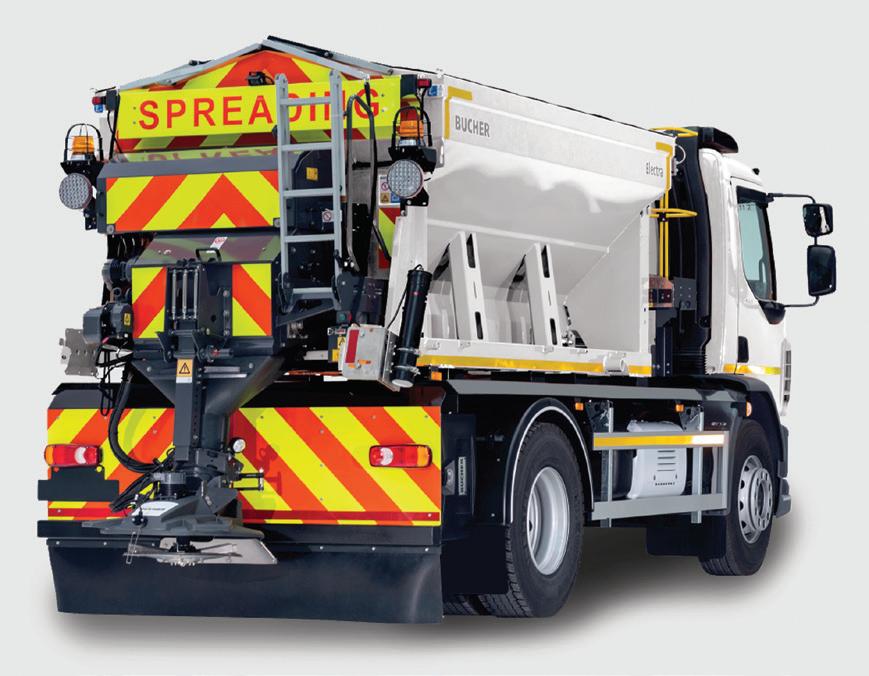


Keep Britain Tidy has launched a new waste hierarchy intended to better engage the public about waste prevention
Environmental charity Keep Britain Tidy has revealed a new version of the waste hierarchy. The release is part of new guidance to help the industry communicate effectively and consistently about waste prevention and at the same time, accelerate the UK’s transition to a circular economy.
Research carried out by the charity has revealed that people generally default to recycling and there is a lack of understanding that recycling is actually the third best option, behind reduce and reuse, when it comes to waste.
The research found confusion around the terms ‘Reduce, Reuse, Recycle’ with 30 per cent of people believing the words are interchangeable.
The report found that current communications are not sending the necessary message that people need to instead prioritise reducing what they buy, and extending the life of the things they have, above recycling.
The research was carried out, as according to Keep Britain Tidy, consumption at its current level is wholly unsustainable.
The report states: “Our current economic model is one of taking materials from the Earth, making products from them and throwing them away, and doing so at an unsustainable rate.
“Instead, we need to live within our fair share of the world’s natural resources and move to a circular economy whereby waste is eliminated and products and materials are circulated at their highest value for as long as possible.” E








F It was also revealed that waste is seen as something to be ‘managed’ rather than prevented and that people are focused on the environmental impact of throwing things away rather than the environmental impact of having the things in the first place.
Keep Britain Tidy’s research report was made possible thanks to CIWM, Greater Manchester Combined Authority, Merseyside Recycling and Waste Authority, SUEZ Recycling and Recovery UK, as well as players of People’s Postcode Lottery.
Waste prevention
The new hierarchy has been informed by usertested research insights and emphasises the importance of mindful consumption.
It has already been shown to better educate the public about waste prevention.
The new hierarchy features logically grouped levels, more detailed descriptors than the catchall ‘reduce’, ‘reuse’ and ‘recycle’ terms and is highly visual, with images and symbols suggesting types of items and behaviours to consider. After seeing the new hierarchy, 71 per cent of research participants said it was clear what it was asking them to do, 58 per cent recognised better ways to minimise their environmental footprint beyond recycling and 51 per cent felt motivated to protect the planet.
Allison Ogden-Newton OBE, chief executive of Keep Britain Tidy said: “We have made a lot of progress by emphasising the recycling part of


The new hierarchy has been informed by usertested research insights and emphasises the importance of mindful consumption
the waste hierarchy. But we can’t just recycle our way out of the climate emergency; we urgently need to shift mindsets and make reuse and consumption reduction a social norm.
“Embracing better, insight-led communications like this new waste hierarchy is an essential piece of the puzzle as it will have a significant bearing on how widely adopted reduce and reuse behaviour become. We urge practitioners across the industry to follow our new guidance and, vitally, to come together to tackle the issue.”
The hierarchy, which is freely available to download and use, has been released that the same time as Keep Britain Tidy’s new report. The report has been designed to provide local authorities, and those in the waste sector and beyond, with practical, evidence-based tips on effective waste communication. The report has been compiled using desk research, focus groups and a YouGov survey, and urges the industry to speak with one voice.
The report has four recommendations. E


It was highlighted by respondents that the government has a key role to play
The research shows that the public want to hear more about how they reduce their waste and consumption. In the survey, 71 per cent of people said there should be less advertising asking them to buy things and more information about how to make changes to the things they buy to reduce their environmental impact.
It is important to note that those campaigning for waste reduction are up against marketing campaigns with huge budgets asking people to consume more.
Keep Britain Tidy argues that it is vital the industry collaborates and that consistent communication comes from a multitude of sources so that it is able to compete with the other advertising campaigns urging people to buy.
The report recommends avoiding ‘catchall’ terms like ‘Reduce, Reuse, Recycle’ and instead advocates highlighting specific behaviours. This could be, for example, refering to using a recycling bin, rather than just recycling.
It is also recommended to communicate in succinct, everyday language and use simple phrases like ‘throw away’ instead of jargon like ‘dispose’.
There should be a shift in focus onto guiding the public to rethink their decisions around the things that they buy and use, and not just what they throw away and how.
Keep Britain Tidy has pointed out that it is important to make clear why people need to make changes to what they buy, use and throw away and what the end goal is.
The research participants also said they want explicit information on what the end result will be and what measurable impact their behaviour can have.
It is important that the public’s ongoing efforts to reduce waste are acknowledged, as well as celebrated to help motivate them and encourage further positive waste behaviours.

The research found that 47 per cent of people want to hear information relating to waste prevention from their immediate social networks, their friends and family.
It was highlighted by respondents that the government has a key role to play (32 per cent), but that charities (41 per cent) and local councils (38 per cent), are also necessary to positively influence people’s behaviour. E













F Those involved in the research said that waste prevention needs to come top-down from multiple trusted and transparent sources that the public feel have good, genuine intentions to make a difference. They also want to receive communications at a community level so it is important to harness the power of local groups, organisations and social networks.
To support the report, Keep Britain Tidy has also produced a free video available to download here aimed at helping the public better understand waste prevention.
Lee Marshall, director of innovation and technical services at CIWM said: “Residents’ understanding of the services our sector provides, and the ways they can do their bit to help us move to a world beyond waste, is crucial if we are to embed a circular economy and manage resources sustainably. CIWM were delighted to be part of this research, which takes our understanding forward another step and should help all those who are using the waste hierarchy as a hook for communications on resources and waste issues.”
Michelle Whitfield, head of communications & behavioural change for Greater Manchester Combined Authority said: “Recycling is now a social norm, however the link between over consumption and climate change is not well understood. If we are to meet climate change targets and move to a more circular economy, it’s vital that we’re able to clearly communicate the steps we all need to take to reduce the stuff
“Recycling is now a social norm, however the link between over consumption and climate change is not well understood”
we buy and value our resources. This report provides us with the tools we need to have those conversations with Greater Manchester residents so that we can all take steps to shift our behaviour.”
Lesley Worswick, chief executive of Merseyside Recycling & Waste Authority said: “Merseyside Recycling and Waste Authority is pleased to be part of this project with Keep Britain Tidy. Using what you’ve got, buying only what you need, repairing and reusing – these are behaviours we want to see become second nature, rather than a second thought.
“Recycling and waste prevention go hand in hand and are both positive behaviours that encourage people to take care of their local environment. People want their community to be cleaner and greener. Promoting waste prevention messages can help to make sure we’re giving people the correct information and practical advice to live zero-waste lives.” M
www.keepbritaintidy.org/ understanding-waste-prevention















The British Association of Removers looks at how local authorities can procure removal services
The fact of moving home is well documented as being the third most stressful life event, behind only death and divorce, and so the vulnerability of all home movers is inevitably heightened during that process. That vulnerability is of course magnified even further for those individuals and families who are already challenged by a myriad of other factors such as disability or social issues. It is imperative therefore that full and proper due diligence is completed on any appointed service providers, in this case removals companies, to ensure that they are properly qualified to carry out the necessary tasks skilfully, efficiently and most importantly with great care and consideration for the circumstances of all parties involved.
The Removals Industry is fairly unique in that what is absolutely true is that one size most definitely does not fit all, rather each move is
an individual experience that is determined by a unique set of circumstances (a selection might include; death; divorce; schools/children; career; family issues; upsizing/downsizing; financial issues/considerations etc.) and so every solution or move plan has to be tailored to meet the specific needs of the task in hand in order that the home mover engages with a service provider who not only has the technical knowledge and skills, but who can also be empathetic with those ‘feeling the strain’.
It also needs to be recognised, that the industry is still largely unregulated and there is nothing to stop anyone from buying a van today and advertising themselves as a removals ‘expert’ tomorrow, assuming that said vehicle is taxed and insured although that may not always be true. There are a number of Trade Groups in the marketplace now who claim E

• Domestic and commercial property clearances
• High reuse rates across all types waste streams
• CO2(e) Savings Reports after each project
• Waste Hierarchy imbedded in processes
We clear all items, including furniture, electrical items, hazardous items, machinery, personal effects and waste from domestic and commercial properties
Since 2009 Clearance Solutions has a proven track record of achieving extremely high reuse rates. In 2023, we managed to get over 400 tonnes of furniture and other items reused, saving over 2500 tonnes of CO2(e)
0207


F to apply regulation, but it is an absolute fact that the British Association of Removers is the only properly constituted Association in the sector, and is certainly the only one that applies regulation in an open and auditable way. So, how is that done?
The Association
The key purpose of the Association is one of applying regulation to prevent unfair and/ or unscrupulous practices, and its focus is on providing evidence to the home mover that Membership of the BAR guarantees quality management and service delivery procedures that are enhanced by independent dispute resolution and advanced payment protection plans.
The Association provides guidance to the home mover/Purchasing Authorities on how to choose a mover, as what matters the most, and costs the least, is having a safe and successful outcome.
All Members of the Association are VAT registered and, as such, are properly constituted businesses that are not simply fuelling the black economy as many in the sector unfortunately do. Furthermore, they are required to comply with two sets of ‘rules’, with compliance being both mandatory, and tested every year at every operational location for each Member. Those rules are as follows.
Members and Applicants must be able to demonstrate that they have the financial resources to operate a legitimate removal business
Finance - Members and Applicants must be able to demonstrate that they have the financial resources to operate a legitimate removal business, and be of good financial standing, providing to the Association or its authorised agent whatever evidence is reasonably required to establish this.
Good repute - proprietors, partners, directors, shareholders or any person concerned in the management of the business of Members and Applicants must not have a police record, have been declared bankrupt and/or have been disqualified as a director.
Insurance - Members and Applicants must protect the customer against loss or damage to their goods submitted for removal and/ or storage, by an approved method, namely: offering and arranging insurance for the benefit of the customer [Insurance Terms] or promising to compensate the customer for loss or damage and having insurance in place to back up that promise [Liability Terms]. In each case the insurance policies referred to must meet the prevailing minimum standards set by the Association.
Premises - Members and Applicants must have a dedicated office area (with safe exclusive external access, if contained within a residential premises), for customers, and the facility should be appropriately signed, and provide a professional, disciplined and wellregulated appearance. Offices should be staffed during normal office hours. If storage facilities are offered, then these must be completely suitable for the purpose, and safe, secure, well maintained and administered.
Staff - Members and Applicants must be able to demonstrate that all staff employed, hired or engaged, are suitably trained and qualified. An induction programme including full health and safety procedures must be in place for all staff, and written records must be kept of the training undertaken by each employee. There must be evidence of a complementary, and continuing, training programme. All staff directly employed by a Member or Applicant, whether they are E
R i c h a r d J a m e s W a s t e
M a n a g e m e n t



H o u s e
c l e a r a n c e
G a r d e n
c l e a r a n c e S h e d r e m o v a l
A p p l i a n c e
c o l l e c t i o n
F u r n i t u r e r e m o v a l
B i n c o l l e c t i o n
H o u s e
c l e a r a n c e &
P r o b a t e

L o o k i n g f o r a w a s t e r e m o v a l s o l u t i o n t h a t ’ s r e p u t a b l e a n d
a f f o r d a b l e ? W e o f f e r a f r i e n d l y , p r o f e s s i o n a l a n d r e l i a b l e s e r v i c e
c o v e r i n g B e r k s h i r e , O x f o r d s h i r e , B u c k i n g h a m s h i r e , S u r r e y a n d H a m p s h i r e .
info@richardjwaste co uk
www.richardjwaste.co.uk
07563 110932
B l o c k
m a n a g e m e n t
E s t a t e
m a n a g e m e n t
C o m m u n a l
w a s t e &
r e c y c l i n g a r e a s
T r a d e w a s t e
c o n t r a c t s
G r e e n w a s t e w o r k

F permanent, temporary, full-time or parttime, or provided by an Agency or other third party (and paid by the employer), must be paid through PAYE and all staff must have a relevant formal contract.
Vehicles - Members and Applicants must be able to demonstrate that they have suitable vehicles and the capability and resources to maintain, adequately equip, and safely operate those vehicles and associated plant and equipment. They must either: possess a Standard National Operator’s Licence where legally required or where an O-Licence is not legally required, employ a person holding a Certificate of Professional Competence (CPC) or equivalent qualification/exemption (e.g. NCRM or higher qualification).
Packaging, materials and equipmentPackaging and materials must be of appropriate shape, size, and strength, and of a quality maintained throughout the life of the material. Access must be readily available to all removals equipment necessary to the task and this equipment to be properly inspected and maintained at all times.
Administration - Members and Applicants must maintain adequate procedures to cover the key elements of the removals process, for
Members and Applicants must be able to demonstrate that they have suitable vehicles
example; quotations and acceptances; bookings and confirmation; job sheets or equivalent; after sales service; customer correspondence, complaints record, claims record, and satisfaction responses.
The above listing is simply a snapshot of the areas where we require evidence of compliance, the actual criteria and annual audits are much more detailed of course.
The British Association of Removers Code of Practice is the only code in the moving industry that’s approved and monitored by the Chartered Trading Standards Institute and the purpose of the code is to ensure the standards of service the home mover will receive; the quality of the materials used; the standards of vehicles and warehouses; staff training requirements; and what will happen if something goes wrong.
And most importantly the Code requires BAR moving companies to deal with the home mover in a courteous and sympathetic way at all times. Compliance with the code is mandatory and each Member is promising to act fairly and reasonably with their clients and to uphold all the standards contained in the Code. Protection is also provided by way of an advance E
Anyone with a van could “take it away”. But that’s never enough…
Swansea – Neath – Port Talbot – Pontardawe – Llanelli – Burry Port
Every house clearance is different. As we sort through years of bric-a-brac, there are sharps to avoid and hazardous items to dispose of carefully. There are things to rehome and things to recycle, followed by minimal landfill.
It takes judgement and expert handling, plus a personal touch – sifting through someone’s life story always calls for discretion.
At Wayne’s World of Waste Removal, we take this duty to heart. Whether it’s a death, eviction or end of tenancy, you can rely on us to dispose of every item responsibly.
Licensed Upper Tier Waste Carrier – Natural Resources Wales
Compliant with Environmental Protection Act (Duty of Care) 1990 and Waste
(England and Wales) Regulations 2011
Insured for Public, Product and Employer’s Liability
Detailed RAMS with strict lifting procedures and PPE
Transfer Notes for every job confirming chain of custody
Reuse & Recycle to minimise landfill
Call 07505121488
www.WaynesWorldOfWasteRemoval.co.uk




















F payment guarantee and an independent dispute resolution service (via The Furniture and Home Improvement Ombudsman) in the event that something goes wrong with a move. Our commitment to the code also provides the home mover with terms and conditions of business that are compliant with current home mover landscape regulations.
So when procuring moving services, any Authority must as a minimum carry out proper due diligence on who they may be inviting into their home. BAR Membership can be verified by clicking on the TSI logo which will be found on Members’ own websites.
Authorities or home movers should research a potential service provider’s website to look for feedback reports, which in the case of a BAR Member company, can also be found on the BAR website. Ask for references and then take them up.
If they have the opportunity, those procuring services should visit the service provider’s premises to experience first-hand how they operate and if possible, speak to staff and take opinion from other clients which is always useful.
Always get a minimum of two quotations and for preference three, possibly via an approved supplier listing. Quotes must be considered on a like for like basis (i.e. is the service provision described exactly the same) and not simply on the price at the bottom of the page.
Always get a minimum of two quotations and for preference three, possibly via an approved supplier listing

Check the Ts and Cs for potential additional charges and how/when they may be incurred (a bona fide professional remover will always explain this to you as part of their quotation process).
This listing is not meant to be exhaustive, rather it is simply a quick over-view of some of the things that a Purchasing Authority must consider for when selecting a service provider. M
For more detail please go to the BAR website which can be found at www.bar.co.uk


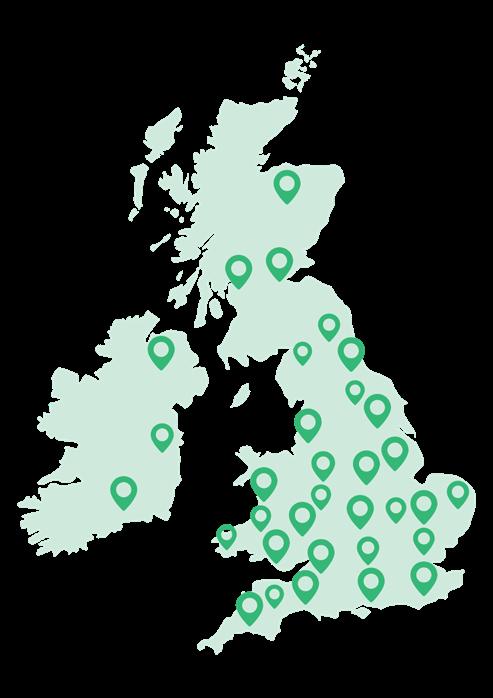








The Property Care Association have a look at some of the invasive species we should be aware of, besides Japanese knotweed
In the realm of invasive non-native species (INNS), Japanese knotweed undeniably takes centre stage, often referred to as the poster child of invasive plants. However, as attention remains focused on Japanese knotweed, there exists a diverse spectrum of other invasive nonnatives that dwell just beyond the spotlight. Despite their comparatively lower recognition, these frequently overlooked plants harbour substantial disruptive potential, waiting to make their mark to our homes and wider environment.
The concerns…
Our concerns which surround invasive nonnative plants should not solely be around the potential damage they could cause, but actually how easy it is for them to spread and how our own interactions are furthering their propagation.
Invasive non-native plants spread via thousands of wind-driven seeds, or tiny fragments of rhizomes within the soil. These invasive species have the capacity to spread quicker than we can remediate and will capitalise on any mistakes we make in the process of their removal. Early identification aiding to the prevention of spread should be considered the highest priority, but what plants should we be focusing on?
The urban legend that defines Japanese knotweed
The scientists at CABI produced a report in 2023 that identifies Japanese Knotweed (Reynoutria japonica) as being the most costly non-native invasive plant within the UK economy. A staggering £246.5 million is required each year to subsidise the significant impact caused by a plant which produces no seeds and almost E








F solely relies on human created pathways like fly tipping to spread.
Whilst the importance of managing this plant should not be underestimated, there is a common online narrative perpetuating a public perception that can unfairly impact property sales. Acknowledging that simply leaving Japanese Knotweed to rampantly spread is ill-advised, yet having a significant sum wiped from the value of a property for a plant which has an “alleged” ability to damage buildings seems unfairly disproportionate.
The need to provide balance
In an effort to provide a more nuanced understanding, a comprehensive literature review conducted by Mark Fennell, Max Wade, and Karen Bacon, supported by Royal Institute of Chartered Surveyors (RICS) and the Property Care Association members sought to scrutinise the plant’s structural impact and assess the reliability of the commonly cited “7m rule.”
The Environment Agency (EA) Code of Practice for Japanese knotweed management initially endorsed the “7m rule” stipulating rhizome extension as reaching “7m laterally from a parent plant.” However, a decade later, it became evident that this rule lacked statistical robustness. The study, which challenged previous assumptions found that Japanese knotweed rhizomes rarely extended beyond 4m
The study highlighted Buddleia (Buddleja davidii) as a potential greater risk
from above-ground plants. Significantly, the research dispelled the notion that Japanese knotweed causes substantial damage to built structures, even when in close proximity with any observed damage comparable to that caused by trees or woody climbers.
Interestingly, the study highlighted Buddleia (Buddleja davidii) as a potential greater risk, exhibiting a damage score of nearly five times higher than that of Japanese knotweed. This begs the question: should we shift our focus to other, potentially more damaging invaders to our built structures like Buddleia?
Buddleia: seeds of destruction
Buddleia, a revered ornamental plant renowned for its attractiveness to butterflies. It has an astounding capacity and resilience to flourish in soil-depleted environments and in particular for structures constructed with lime mortar. Buddleia’s invasive capabilities become heightened as the plant adeptly takes root even in the minutest crevices. As Buddleia thrives, its roots intricately weave amongst brickwork causing cracks. This in turn raises concerns E












Rhododendron has the capacity to overshadow extensive woodland areas
F about potential structural implications such as heightened water penetration, leading to issues like dampness and mould.
Buddleia is commonly observed hanging from buildings, railway arches, or emerging from boundary walls thanks to its wind-driven seed dispersal. Despite its relatively modest economic impact on the UK, amounting to £1.4 million per year, its status as the fourth most costly invasive non-native plant becomes particularly significant when we consider it faces no legal restrictions. Nor are there any restrictions imposed by mortgage lenders highlighting a gap in regulations concerning invasive plants.
While the public’s anxiety surrounding Japanese Knotweed may appear disproportionate, the technical evaluation suggests that Buddleia merits heightened attention within the realm of invasive nonnative plants in the built environment.
Rhododendron:
an environmental challenge
While Buddleia has been recognised for its impact on built structures, it’s Rhododendron Ponticum that poses a significant threat to our natural environment, particularly in Scotland,

where an estimated 50,000 hectares of infested soils are under management. Ranking as the second most expensive invasive non-native plant, it incurs an annual cost of £6.2 million as it steadily encroaches and spreads upon native woodlands.
Beyond its rapid spread, Rhododendron has the capacity to overshadow extensive woodland areas, reducing sunlight availability to groundlevel vegetation. Attempting to completely remove or excavate Rhododendron Ponticum does not restore the ground level habitat to its original state where native flowers can bloom E


Our aim should be to encourage better identification of these invasive plants

F and studies in Scotland have revealed that, even after 30 years, native flora failed to make an unaided full return.
Despite being subject to legislation identical to that governing Japanese Knotweed, its availability in garden nurseries nationwide raises concerns about the effectiveness of current regulations. The ease of access of invasive plants only further proliferates their spread once they escape the confines of a garden.
Bamboo: comparable dangers
The accessibility of invasive plants is a notable concern, but few have been placed on a pedestal quite like bamboo. Once celebrated as “the perfect screener” in numerous garden makeover shows during the early 2000s, unfortunately, there is now a recent surge in disputes between neighbours over encroachment issues casting a shadow on this once-beloved species.
Very few plants can rival Japanese Knotweed in terms of its potential to disrupt a homeowner’s amenity enjoyment, yet some varieties of Bamboo have the capabilities to produce a root system which can extend beyond 10m. It is essential to recognise that not all bamboos are invasive and have such capabilities. Applying a metaphorical net across

potentially 1,500 different species globally and labelling them all invasive would be detrimental. The immediate focus should be on “invasive bamboos”, and whilst CABI have not highlighted their economic impacts, these varieties are definitely on a watchlist by many invasives species experts.
Notable species include: Golden Bamboo (Phyllostachys aurea); Yellow Grove Bamboo (Phyllostachys aureosulcata); David Bissetti Bamboo (Phyllostachys bissetti); Black Bamboo (Phyllostachys nigra); Arrow Bamboo (Pseudosasa japonica); Umbrella Bamboo (Fargesia Robusta “Pingwu”); and Broad-Leaved Bamboo (Sasa palmata).
These bamboo species are particularly notorious for their capability to expose weaknesses within structures, impact or dislodge hard landscaped features, or lead to amenity value loss within gardens. It’s within this ability to damage structures and disrupt gardens which warrants further research and risk evaluation, preventing another potential “Knotweed narrative” from taking root.
The importation of exotic goods and plants is an industry which extends to all corners of the globe. However, it is within this desire to import
exotic plants which has resulted in a significant shift within our botanical makeup.
Plant Atlas 2020 has highlighted how the metaphorical scales are beginning to tip. 51 per cent of plants within the UK are now non-native, and 58 per cent of these non-native plants cover an area larger than first recorded in the 1950s. Whilst non-native plants are not always a problem, it’s these select few which become “invasive” that we should be addressing.
Our aim should be to encourage better identification of these invasive plants, which can be gained through free online guides or professional training. This will allow for earlier identification, thus in turn will allow infestations to be halted before they can spread to an almost uncontrollable state.
Most importantly our aim should be to utilise competent, accredited professionals and their knowledge to implement biosecurity measures and reducing the risk of spread. Only then can we begin to break the cycle of spreading invasive non-native plants and reduce the economic impacts they have. M
FURTHER INFORMATION
www.property-care.org





Robyn Quick investigates how funding from the cancelled part of HS2 is being reallocated to road maintenance across the country
HS2 never seems to be far from the headlines, and it has been a hot topic since its first investigation back in 2009. For those that need a refresher on where we are with the development of the high-speed railway, we’ve got you covered. It was designed with the goal of linking major cities in the Midlands and the North of England to London. Since the project was announced to go ahead in 2012, however, it has been consistently delayed. Eventually in October last year, prime minister Rishi Sunak announced the Manchester to Birmingham stretch of the rail project would be scrapped.
The government said some of those funds will be reallocated to England’s local councils over the next 11 years for road maintenance. They said £8.3 billion of funding will go towards road maintenance across the country, but councils said the cost of repairing local roads will be closer to £14 billion.
The Department for Transport now says local authorities in England will get an extra £150m for road repairs this year, and the same amount for 2024 and 2025. The rest of the funding will be allocated over the next decade. Councils will be held accountable for how they spend the money by being required to publish regular updates on the proposed works and they could see future money withheld if they fail to do so.
The aim is to make roads safer and smoother for vehicles. After all, a Royal Automobile Club (RAC) Report on Motoring found that a lack of maintenance on UK roads causes the most frustration for users.
But what has the government actually got planned?
Network North
Network North is the largest project using reallocated funds that is in the works.
One of the announcements the Department of Transport released in December last year
£3.3 billion has been given to local authorities in the North West, North East and Yorkshire and the Humber
is that they plan to upgrade and repair roads across London as part of Network North. £235 million will be poured into the project across an 11-year period, and RAC said this could save motorists up to £440 in repairs caused by poor road conditions. The government is allowing authorities to start spending immediately on vital road repairs, with £7.5 million of this funding set aside for next year.
The government said this project will mean Londoners can enjoy smoother and safer journeys. Transport secretary Mark Harper said: “This government is on the side of drivers and is investing £235 million to improve and repair London’s roads, part of the biggest-ever funding uplift for local road improvements.”
This is the first time in eight years that the government has given funding in London for the roads to be significantly improved.
Outside of London, £3.3 billion has been given to local authorities in the North West, North East and Yorkshire and the Humber to resurface the roads.
RAC head of policy, Simon Williams, said: “Drivers’ biggest bugbear of all is the poor condition of local roads, so the fact the government has found a significant additional pot of revenue should give councils the certainty of funding they need to plan proper long-term road maintenance, something we have been calling for many years.”
He also said that they hope local authorities will use the money “in the most effective way possible by resurfacing the very worst roads, keeping those in reasonable condition in better states for longer through surface dressing and filling potholes as permanently as possible wherever necessary.”
He added: “This should in time go a considerable way to bringing our roads back to a fit-for-purpose state and saving drivers hundreds of pounds in the process from not having to fork out for frustrating repairs to their vehicles.”
We will have to see if this funding will be a long-term solution to the UK’s road maintenance issue, but some local councils have already criticised the project.
For example, Yorkshire Post reported that Wakefield Council’s cabinet members said the investment falls well short of the amount needed to improve roads, footpaths and cycle lanes. L


























The winter months are coming to an end, but it was only last June that the AA Pothole Tracker revealed pothole incidents were at their worst. How can local authorities reduce potholes on our highways?

Poor ironwork can be a contributing factor to the formation of potholes. Road surfaces fail for many reasons, but an often-overlooked cause is poor ironwork installation that is unsympathetic to its environment. This can then cause weaknesses in the bedding material with up to 44 per cent of access covers suffering a failure of the paved surround.
Focusing on the root cause can help local authorities reduce their pothole pain. Switching from a patch repair approach to a longer-term focus, means choosing the right specification of ironwork and materials. It also helps local authorities break the cycle of resurfacing and filling potholes cheaply and quickly which can prove to be a false economy resulting in greater long-term costs and a higher environmental impact.
The ideal ironwork should include features that combat the typical modes of failure that we see on UK roads, such as a rigid I-beam for high performance load transfer, BS 7903 frame gussets for overall frame rigidity, surface texturing above and below the flange for maximum mortar engagement and an optimal seating position within the frame to minimise friction wear and frame flex.
Wrekin Products has published a report that sheds light on the relationship
between failing ironwork and the UK’s extensive pothole problem.
‘Potholes - More Than a Surface Issue: Helping Local Authorities Find Solutions to the UK’s Pothole Problem’ combines industry voices from voices in local authorities, Gaist (a provider of roadscape intelligence solutions), and the Local Council Roads Innovation Group. It delves deeper into the wider impact potholes are having on councils and the benefits of a longer-term approach.
The report includes findings from Derby City Council which says that finding a longterm solution comes down to investing in the infrastructure so that we’re not just maintaining a failing structure. You need much more solid ironwork, and the framwork needs to be strong and structured. Longevity is also key. A permanent repair, done properly, generally lasts for quite some time. L FURTHER INFORMATION
www.wrekinproducts.com/potholes





A host of new features, interactive demos, international pavilions from across the globe, and a charity Gumball Rally across the country have all been announced by the organisers of the UK’s largest event for the built environment, UK Construction Week (UKCW), which makes a welcome return to London’s ExCeL from 7-9 May 2024
The multi award-winning show will see the debut of a new Live Demo Theatre; Skills and Training Hub; a construction-specific Recruitment Zone; new C-Suite Summits; a ‘Gumball Rally’ which finishes at UKCW London; a host of international exhibitors housed in pavilions from India, China, Turkey, Italy, Spain, Germany and France. UKCW London is once again co-located with Concrete Expo and The Offsite Show, as well as the UK’s premier event for the self-build sector, Grand Designs Live. New features at UKCW London include:
A showcase of the latest construction products, techniques and innovations from across the world, the Demo Theatre will bring them to life in front of a live audience of industry professionals looking to be ahead of the curve.
An exclusive new area for the sector’s top decision makers, the C-suite Summits will see top execs offering their invaluable insights and forecasts to their peers. The new zone will also be a top-level networking forum for dialogue and debate.
A first-time collaboration with the CITB (Construction Industry Training Board), the new hub will address the Skills Shortage head-on with a three-day programme featuring a myriad talks and workshops to support skills development within the industry and ultimately, build better.
Another new area created in response to exhibitor and visitor feedback, this will not E







F only be a focal point for all those working in recruitment, or simply looking for that next new role. Visitors will have face-to-face access to specialist recruiters from the construction sector, with discreet interview rooms allowing candidates to have onsite consultations.
Spearheaded by UKCW regulars Construction Sport, a charity which supports construction workers’ mental and physical health through sport, the Gumball Rally will see teams of drivers navigate their way across the UK, stopping off at famous infrastructure projects - raising funds along the way. Two rallies will

take place in 2024, each in the week prior to the UK Construction Week shows in London (May) and Birmingham (October). More details will follow in the coming months.
The largest international representation of manufacturers to date at any UK construction event. Businesses from India, China, Turkey, Italy, Spain, Germany and France will take centre stage at UK Construction Week London, bringing together myriad innovations from across the world.
Sam Patel, UKCW event director, commented: “Construction is a fast-paced and evolving industry, and so our show needs to reflect that - hence the new areas which focus on skills, training and recruitment to address the skills gap which we all know has been affecting the sector for a number of years.” Registration for UKCW London is now live (and free) through the new-look website.
The London show is complemented by its sister event, UKCW Birmingham, which takes place at the NEC from October 1-3.
The NEC was the birthplace of UK Construction Week in 2015 and the trade show has grown to become the UK’s largest built environment event. Details on the Birmingham programme of events and speakers will be announced in due course, but exhibition space is already filling up - to enquire for your business, contact Info@ukconstructionweek.com To find out more about both shows and to register for UKCW London for free! M
For more information, contact the UKCW press team at UKCW@cabcampaign.co.uk

whatimpact

Councils play an important role in giving baseline funding for local charities, social enterprises and community groups (VCSEs) in the form of community grants. Government Shared Prosperity Fund (SPF) grants, currently being distributed all across the country, are another significant source of funding for various levelling-up projects in various remits, such as culture, heritage, and sports. It is widely recognised that the traditional grant-making process is daunting and timeconsuming for applicant VCSEs. They have to fill in long applications, which in many cases require professional grant-writing skills –and take an unreasonable amount of time. Council evaluation processes are hard to keep unbiased, as applications lack comparability in data. Finally, when it is time to report on the impact of projects, and for the council to provide audit-ready data for compliance purposes, a vast amount of time and money must be used to collect and analyse the data. whatimpact has built an efficient technology for grant-matching and evaluation processes – a scalable model for any council to use. Overall, it is all about finding the ‘best match’ through a comprehensive matchmaking marketplace to allocate funding to those local projects meeting the outcome requirements of grants. whatimpact offers a streamlined application process with validated, comparable data for a democratic evaluation process pulling data from all Charity Commissions, Companies House and 360Giving. All grantees report on the impact by using a comprehensive SPF-aligned impact reporting tool.
Newport City Council (NCC) has successfully started using whatimpact to distribute Shared Prosperity Fund grants worth £800,000 in total for sports, culture, and heritage projects. There has been a surge in the number and quality of local and nationwide VCSEs proposing projects to Newport. The NCC steering group has found the application evaluation and scoring system extremely helpful. All stages of the process are contributing to audit-ready grants dashboard and documentation.
Overall whatimpact has built a robust, holistic grant-management tool to make sure the most impactful initiatives are being funded and outcome targets are met. This technology saves both costs and time from administration and makes the application process transparent, democratic and fair. Check Newport City Council’s grant-making schemes published on whatimpact.com HERE . Contact shona@whatimpact.com to book a demo to learn about the management tool. L
whatimpact.com is the leading Social Value Brokerage and VCSE matchmaking marketplace in the UK. In addition to the grantmaking system, the company offers solutions for social value delivery for public sector procurement and government suppliers.
www.whatimpact.com


Scotland is a captivating destination that offers ideal settings for corporate meetings and events, incentive trips, and association conferences. With its breathtaking landscapes, rich history, vibrant culture, and world-class facilities, Scotland has everything you need to ensure your event is memorable and successful
One of the key reasons why Scotland stands out as an excellent choice for such events is its diverse range of venues. From historic castles and palaces to modern conference centres and luxurious golfing resorts, Scotland offers a wide array of options to suit every taste and requirement. Whether you are seeking a traditional setting or a contemporary space, Scotland has it all.
Scotland is a thriving innovation hub with renowned academic institutions and key industries, which makes it the perfect destination for events focused on knowledge exchange, networking, and collaboration.
The country is famous for its natural beauty, which adds a unique and enchanting element to any event. From the rugged highlands to the stunning lochs and picturesque coastlines,
the country’s breathtaking landscapes create an awe-inspiring backdrop for your gathering. Whether you are organising team-building activities in the great outdoors or planning a gala dinner, Scotland’s idyllic settings will undoubtedly leave a lasting impression on your participants.
With eight distinct cities and an impressive array of event venues, including conference centres and luxury venues, Scotland offers an extensive range of options to cater to specific needs.
Aberdeen
Aberdeen, also known as the “city of energy”, has established itself as a global hub for energy production, and research. The city is home to E


Edinburgh is home to universities and research institutions that are at the forefront of innovation and research
F an array of companies, research institutions, and professionals in the energy industry, making it a prime location for conferences and events related to this sector.
Dundee
The city of Dundee is a vibrant hub for the cultural and creative industries and has been recognised as a UNESCO City of Design. Dundee is also renowned for various art forms including music, theatre and literature, it is home to the world’s only V&A museum outside of London.
Edinburgh
Scotland’s capital, Edinburgh, is widely recognised as one of the most attractive destinations in the world, celebrated for its perfect fusion of culture, arts, heritage, dining and music. Edinburgh is home to universities and research institutions that are at the forefront of innovation and research in computer science, engineering, and medicine. These expertise have attracted several events and conferences to the city.
Glasgow
Known as the world’s friendliest city, Glasgow offers a unique blend of Scottish culture and character. The city, which has a vibrant music scene and is recognised as a UNESCO City of Music, has a range of venues including convention centres, hotels, distilleries, and
stately homes. Glasgow is a hub for cuttingedge life science and pharmaceutical research and boasts expertise in fields such as energy, engineering, photonics, and satellites.
Inverness
Inverness, located in the Scottish Highlands, offers awe-inspiring locations for corporate events. It is a destination of discovery, heritage, and culture and home to the iconic Loch Ness.
St Andrews
Located an hour outside of Edinburgh, St Andrews is a charming destination boasting amazing venues, including 5-star resorts, country estates and castles. St Andrews is known as the Home of Golf and is also home to Scotland’s oldest University.
Scotland serves as an exceptional host for association conferences, corporate meetings, and incentives with the opportunity to engage with local communities and academics including scientists, engineers, business leaders and charities, establishing valuable connections and exchanging knowledge.
Building on a legacy of innovation, Scotland has risen to the forefront of globally significant sectors, including renewables, engineering, technology, life sciences, and marine exploration. Scotland’s strengths in these key sectors are helping to attract industry-specific
events such as the Arctic Science Summit Week (21 - 29 March 2024, Edinburgh), All-Energy Exhibition & Conference (15 – 16 May, Glasgow), World Science Fiction Congress (8 - 12 August 2024, Glasgow), Floating Offshore Wind (9 –10 October, Aberdeen) and the International Electrotechnical Commission General Meeting 2024 (19 – 26 October, Edinburgh).
The importance of aligning with the UN SDGs
The United Nations Sustainable Development Goals (UN SDGs) provide a comprehensive framework to address urgent global challenges such as poverty and environmental protection. Goal 17 of the UN SDGs emphasises the importance of partnerships in achieving these goals, recognising the urgent need for collaboration and global action to protect our world and future generations.
In this context, business events have emerged as powerful platforms to facilitate discussions and bring together global communities to tackle significant issues like poverty, healthcare, and climate change. Events provide an ideal opportunity to foster collaboration and generate innovative solutions.
VisitScotland Business Events recognises the potential of business events to contribute positively towards the UN SDGs and aims to
Events provide an ideal opportunity to foster collaboration and generate innovative solutions
showcase a clear connection between the two through its work.
VisitScotland Business Events helps organisers and businesses realise their potential to drive meaningful change and align their work with the UN SDGs by delivering value, education, and a sense of community to delegates and members.
The VisitScotland Business Events team also believes that making an impact extends beyond the confines of the meeting room, which is why they created The Transformation Protocol. This initiative enables business events’ organisers or Scottish stakeholders to connect with a wide variety of organisations and policy makers including the country’s national innovation centres, academic research units, third sector groups, leading industry bodies, Scottish government agencies, investment groups and even with Scottish Government directorates. E


F VisitScotland Business Events recognises the value of business events in connecting experts, thought leaders, academics, and pioneers from around the world. The Transformation Protocol aims to facilitate these connections by involving partner organisations such as FinTech Scotland, Scotland Food & Drink, The Data Lab, Technology Scotland, and the Scottish Association of Marine Science.
By onboarding these partners, VisitScotland Business Events can ensure that events serve as catalysts for social and economic change and capitalise on the opportunity to learn from and forge new relationships with international delegates attending these events.
In addition to The Transformation Protocol, The Policy Driven Model (PDM) represents a shift in strategy to recognise business events as catalysts for social and economic change. VisitScotland Business Events launched the PDM, to shift behaviours in evaluating the impact and success of events.
This approach positions business events as strategic policy partners that drive government agendas and create opportunities for collaboration, research, funding, and investment.
The VisitScotland Business Events team understands that each event is unique and requires a personalised approach which is why the organisation is positioned as a neutral and impartial point of entry and information to Scotland.
This approach positions business events as strategic policy partners that drive government agendas and create opportunities for collaboration, research, funding, and investment
The knowledgeable and friendly team can help organisers find the right venue and accommodation partners, to securing reliable suppliers and experienced DMCs.
The VisitScotland Business Events team are happy to provide inspiration for creating an unforgettable event in Scotland, and offer insights and connections to find the right event partners. They can also make introductions to the right people, ensuring a quick response from key contacts. VisitScotland Business Events believes in the power of events to create meaningful change and can help make introductions that transform an event’s impact. M
To learn more about the work of
VisitScotland Business Events visit: https://businessevents.visitscotland.com

Food, Drink & Hospitality Week comes to ExCeL London on 25-27 March for three busy days of networking, product sourcing and learning about the very latest industry trends
A new umbrella brand comprising IFE Manufacturing, IFE, The Pub Show, HRC and historic chef competition International Salon Culinaire, Food, Drink & Hospitality Week is the UK’s biggest celebration of industry innovation with more than 27,000 visitors expected and over 1,500 suppliers taking part in the 2024 event.
Food, Drink & Hospitality Week Portfolio
Director Philippa Christer comments: “The launch of the Food, Drink & Hospitality Week brand is an important step in an exhilarating period of growth for our March portfolio of events, expanding our partnerships with key industry organisations and diversifying our offering to the industry.
“Our vision for Food, Drink & Hospitality Week is a citywide celebration of everything that makes this sector unique: showcasing product innovation, connecting visitors with the trailblazers that can transform their business
and providing a platform for discussions vital to the industry’s future.”
A bustling hub of NPD innovation, IFE Manufacturing is the ultimate product-sourcing platform for food & drink manufacturers and brand owners to do business.
Visit the show to discover sustainable packaging providers, ethical ingredients brands, accreditation and product testing experts, food science and technology innovators, and quality processing equipment suppliers.
On the Trends & Innovation Platform, visitors will hear from leading industry experts on topics at the forefront of food science and food development, including discussions around precision fermentation, allergens, the future of vegan & plant-based, ultra processed foods and the potential applications of AI in food & drink development. E
For over 40 years, IFE has been a trusted resource for buyers in retail, wholesale and hospitality to discover the latest new products, learn more about trends in food & drink and stay ahead of the competition in a market always seeking out the next big thing.
Visitors can explore the very latest new products in the Startup Market, hear directly from brand owners in the New Products Tasting Theatre, meet with suppliers from all over the world and gain key insights into the trends of tomorrow at the Future Food Stage.
New for 2024 is a dedicated Cheese Pavilion, a Fresh Produce Section in partnership with the Fresh Produce Consortium and a Producer & New Supplier Showcase by Aramark.
Plus, the Exporters Hub, in partnership with UK Export Academy, will be providing invaluable insights into international trade, with speakers from the Institute of Export & International Trade, the Department for Business and Trade, British Business Council, the Food, & Drink Exporters Hub and more.
The only UK event dedicated entirely to the pub & bar sector, The Pub Show is a must-attend for owners and operators looking to network with industry peers, sample quality beers, wines and spirits and meet with a wide range of service suppliers to the sector.
In addition to popular returning feature The Taproom, The Pub Show will also be launching The Pub Stage in partnership with the British Institute of Innkeeping (BII) and introducing new opportunities to network in a fun and informal setting in The Beer Garden, designed by Black & Stainless Creative Metalwork. A bustling networking hub and meeting area at the heart of the show, the Beer Garden will also feature a unique pub quiz and bingo event from Hashtag Host.
The UK’s leading trade event for hospitality and foodservice, HRC is back and better than ever next year with countless new features, partnerships and networking opportunities. Visitors will have the chance to source suppliers across Hospitality Tech, Professional Kitchen, Foodservice, and Furniture, Interiors & Tableware, and to explore the brand-new Light Equipment Pavilion packed with quality brands including Contacto, Signature and Denby Pottery. Industry professionals can expect inspiring leaders in the UK hospitality sector to dive deep into the latest trends and best practice on the Vision Stage, designed by Harp Design, and on the TechX stage visitors can learn about the latest developments in hospitality tech and gain advice on how to elevate their tech stack and optimise customer experience.


Highlights of this year’s programme include an in-depth keynote interview with Chef Ambassador Lisa Goodwin-Allen, and a presentation from Kate Nicholls OBE, CEO of UKHospitality, on the impact of changes to the national living wage on the hospitality industry.
The Networking Hub, designed by Design Command, will be partnering with leading associations including Arena, the Foodservice Equipment Association (FEA) and HOSPA to host networking events and opportunities to connect with industry peers. Plus, 2024 will see the return of Chef HQ, curated by Chef Publishing, a demo kitchen, stage and networking area packed with leading chefs from the UK taking deep dives into a range of cuisines, trends and ingredients.
Historic chef competition International Salon Culinaire returns to challenge and inspire chefs of all levels to demonstrate their skills and creativity.
With over 100 live and static competitions taking place across three days including Sugarcraft, Salon Display, Static Display and the Live Theatre, the event is set to welcome up to 1,000 competing chefs for 2024 alongside new competition judges including Cherish Finden, Jason Howard and Afzal Khan.
New for 2024 is the Australian Wagyu Beef competition in partnership with Meat & Livestock Australia, Junior and Senior Pasta competitions in partnership with Dell’Ugo and an evolution of Tilda Chef Team of the Year which will challenge competing chefs to focus on using ‘waste’ or by-products to create delicious dishes. The competition has also welcomed Oatly as a partner for an all-new plant-based challenge.
Don’t miss out on your chance to be a part of the UK’s biggest celebration of innovation in food, drink and hospitality on 25-27 March 2024 at ExCeL London. To find out more about everything happening as part of Food, Drink & Hospitality Week, and to register for your complimentary trade ticket, visit the website below. L
fooddrinkandhospitalityweek.co.uk

•
•
•
•
•
To

The Postal Services and Solutions (RM6280) Framework from the Crown Commercial Service provides postal services to the UK public sector and third-party organisations
The framework gives thousands of public and third-sector buyers the ability to access postal goods and services such as hybrid mail solutions, franking machines, inbound mail receipt and mailroom equipment. For those not in the know, a franking machine is a metering machine used to save time in the postage process.
The agreement also offers audits, efficiency reviews and consultancy services to help you develop your postal services strategy and make sure you are getting the best value for money. Also, buyers will be able to access mail and parcel collection and delivery services both for the UK and internationally.
A range of inbound and outbound services are available to help you transition from a paperbased mailroom to a digital environment. This
includes hybrid mail solutions that incorporate new technologies, such as e-communications and managed service options. Giving you a ‘digital-by-default’ strategy.
The duration of the agreement is four years and is valid until October 2027. However, this call off contract period is flexible and can run beyond the framework expiry date.
The agreement replaces RM6017 Postal Goods, Services and Solutions which expired in November 2023.
There are a variety of benefits relating to the framework.
Lot 1 offers a range of franking machines and mailroom equipment to increase production, E






We transform communications between organisations and citizens by combining the best technology with unrivalled expertise.


F reduce floor space and free up resources. The agreement also provides access to zonal and regional pricing. It introduces new technologies to reduce your physical mail and integrate paper documents into digital workflows, as well as increasing security of mail items by using services such as hybrid mail.
The agreement also enables small to medium sized enterprises (SMEs) to bid for public sector contracts supporting the government’s aspiration for £1 in every £3 to be spent with SMEs and making sure over 50 per cent of suppliers on the agreement are SMEs.
Additionally, buyers can reduce their carbon footprint through digitisation and new energyefficient equipment and services. While on the topic of carbon reduction, all suppliers for the agreement have committed to comply with the Procurement Policy Note 06/21: ‘Taking account of carbon reduction plans in the procurement of major government contracts’ as required.
Support and guidance is available to help buyers optimise their mail processes and achieve savings on their postal services requirements.
There are 33 suppliers on the agreement. For Lot 1, the call off period is six years and Lots 2 to 8 will expire completely in seven years.
Lot 1 includes franking machines, mailroom equipment and associated consumables.
Lot 2 includes the collection and delivery of letters, large letters and parcels within the UK.
Collection and delivery of letters, large letters and parcels for international delivery are included in Lot 3.
Lot 4 encompasses audits, efficiency reviews and niche consultancy.
Additionally, buyers can reduce their carbon footprint through digitisation and new energy-efficient equipment and services
For Lot 5, business process outsourcing, mailroom, document and data managed services are included.
Lot 6 includes hybrid mail, digital and transformational.
The seventh lot encompasses inbound delivery, mail opening and digital scanning services.
Finally, Lot 8 includes security scanning services.
How do I go about buying?
You can use direct award or further competition. Check your organisation’s internal policies and control processes before engaging with suppliers, to make sure you are following your standard operating procedures.
If you want suppliers to propose solutions for your requirements or you need to change parts of the contract (but still follow procurement rules), you will have to hold a further competition.
Direct reward, on the other hand, is suitable if there is only one supplier that meets your requirements or you can clearly establish which supplier meets your needs at the lowest price. M
Postal Services & Solutions - CCS (crowncommercial.gov.uk)



The Payment Acceptance 2 framework allows the public sector to accept card and alternative payment methods either face-to-face or through eCommerce and digital routes. It also provides access to payment (payments in and out) consultancy services
Payment acceptance refers to a process where providers of goods and services are paid by consumers.
Generally, those receiving payments are paid by an ‘acquirer’, a regulated entity who can settle funds from a range of payment types.
The acquirer usually receives funds from the consumer’s card or account ‘issuer’.
The framework includes card acquiring and gateway services – the process of collecting card-based payments from customers and their banks and then giving them to retailers and merchants both in person and online.
It includes other payment acceptance services including: payment equipment, such as chip and pin machines; alternative payment methods (APMs) such as over the phone and the internet; and payment initiation services (PISP) as an optional service.
Specialist payment consultancy services are also included to help customers assess their end-to-end payment landscape. A payment landscape refers to the money customers receive (accept) and how they pay for the services they use (issuance).

The Agreement has a four-year contract period and runs from 19th December 2023 to 18th December 2027.
Benefits of the framework include a transparent fee structure and savings of up to 15 per cent against typical market rates.
The framework allows customers to buy services to meet to specific payment acceptance needs.
It also offers a wide range of suppliers from large nationals to SMEs.
All suppliers for the agreement have committed to comply with the Procurement Policy Note 06/21: ‘Taking account of Carbon Reduction Plans in the procurement of major government contracts’. This can be found on each supplier’s individual page.
Lots
There are 7 suppliers across 3 Lots. Lot 1 Payment Acceptance Services provides access to payment acceptance services, including allowing you to accept payment through faceto-face or unattended point of sale (POS) terminals (such as car parking machines) and providing payments through alternative payment methods (such as over the phone and the internet).
Lot 2: Acquiring and Merchant Equipment Services covers accepting payment (and settlement of funds) through face-to-face or unattended POS terminals (such as parking machines).
Lot 3: Payment Consultancy is for strategic advice to define payment acceptance and payment issuance requirements. M FURTHER INFORMATION
https://www.crowncommercial.gov.uk/ agreements/RM6325




Carrousel Digital is bringing advanced security by patenting innovative data transmission systems notably in the fields of :
Carrousel Digital is bringing advanced security by patenting innovative data transmission systems notably in the fields of :
Ø data transmission using entangled photons
Ø Quantum safe digital signatures using one time keys
Ø data transmission using entangled photons
Ø Quantum safe digital signatures using one time keys
Ø data and e-cash transmission chaining offline transactions
Ø data and e-cash transmission chaining offline transactions
Ø Secure Indoor geo-localisation enabling geo-localisation of data input
Ø Secure Indoor geo-localisation enabling geo-localisation of data input
Carrousel Digital is an intellectual property provider making available its technology to third parties through licensing.
Carrousel Digital is an intellectual property provider making available its technology to third parties through licensing.






GovNet has launched a new flagship conference for 2024 that will bring together the digital, data and technology communities working across central and local government to learn about latest industry developments, share best practice, explore innovative solutions and collaborate with their peers. The inaugural DigiGov Expo will take place on the 8th and 9th May at the ExCeL London
It has been 20 years since GovNet launched its first technology-focused event, Government ICT, in what was a landmark year for digital services. Facebook went live from Mark Zuckerberg’s dorm room in Harvard, Google
went public with one of the most anticipated Initial Public Offerings (IPO) in history, and we also saw the continued roll-out of broadband. Fast-forward two decades, and it is clear we have entered a new digital age, which is having a profound effect on how we work and E

F deliver services. As the cutting-edge solutions we now use, such as generative AI, become more intelligent, intuitive and accessible, the need for education and increased collaboration is more critical than ever before.
This was a key reason behind our decision to consolidate our four existing technologyfocused conferences - Government ICT, the Cyber Security and Data Protection Summit (launched in 2011), DigiGov (2014) and GovTech (2019) - to create a new annual event for the digital, data and technology communities working across central and local government. The result is DigiGov Expo 2024, which is expected to be attended by more than 2,400 public sector tech professionals.
For the past year, our team has been working behind the scenes to create and build an event specifically designed to address key pain points and share tangible outcomes. We have been researching and debating key issues facing the sector to develop an event, from the bottom up, that delivers true value to our audience.
We took the time to speak to delegates, speakers and sponsors from our legacy conferences - and it became apparent that due
to the holistic nature of technology for the public sector, it was critical for our audience to learn about a wide range of topics, from AI regulation to IT infrastructure, all under one roof.
We also recognised the busy schedules faced by many of our delegates, especially post pandemic. Therefore, by combining these events, we are able to provide a more efficient use of their limited and valuable time. Instead of choosing between multiple events throughout the year, attendees can now engage and network with a diverse group of professionals in one cohesive environment. By focusing resources and efforts into one flagship conference, we can provide an exceptional experience that is both rich in content and engagement opportunities, as well as facilitating the ongoing development of this important community.
For the public sector, improving the experience and outcomes for citizens has always sat at the top of the list, but this remains challenging in light of budget constraints and the limitations of some current systems in use. Through a combination of speakers and case studies, as well as via conversations with our growing list of exhibitors, DigiGov Expo will provide a

platform for our audience to discover the latest technologies that can drive efficiencies and enhance how they deliver services for citizens.
From our conversations, we are also aware just how challenging it can be for digital, data and technology professionals working across central and local government to have sufficient time to constantly monitor new trends, developments and solutions, such is the rapid pace of change and a lack of significant time. We are confident that our theatre content, including keynote panels with industry thought leaders, plus our workshops, will enable attendees to forecast future technology trends more effectively and provide a clear and progressive roadmap of what’s to come.
Across the two days, delegates will also benefit from opportunities to collaborate and learn. With time constraints often limiting interaction and collaboration between departments on a day-to-day basis, the workshops, surgeries and networking receptions we have built into DigiGov Expo will help our audience to directly plug into their peers and learn from other project challenges, and, ultimately, their successes.
We have been clear from the offset that increased collaboration will lead to better

service delivery in the long run, whilst also helping delegates upskill and become more effective in their roles, which is increasingly important in light of the well-publicised digital skills shortage across government.
We have assembled a fantastic array of thought-leaders from right across the sector. More than 125 speakers will be present at the event, including: Daljit Rehal, chief digital and information officer, HMRC; Mustafa Aziz, delivery manager, Home Office; Keith Dargie, chief digital & information officer, Crown Office and Procurator Fiscal Service; Lord Francis Maude, former minister for the cabinet, chair of FMA; Mike Hill, chief digital and information officer, Cabinet Office Digital; Tori Olphin MBE, lead data scientist, Thames Valley Police; and Peter Summerfield, DBS DIT Technology and Architecture (TA) chief technology officer, Ministry of Defence. You can browse the full agenda on the event website.
In addition to the expert content, industry professionals will be able to explore cuttingedge solutions from over 150 exhibitors, as well as making valuable connections through extensive networking opportunities. Furthermore, the Crown Commercial Service and GDS have been confirmed as DigiGov Expo’s Strategic Show Partners for 2024.
With just two months to go, the final plans for DigiGov Expo 2024 are underway and we hope you can join us. If you’re a member of the public sector, you can secure your free pass now. M
https://www.digital-government.co.uk

‘Digital transformation’ is a commonly used phrase within the private and public sector, but what does it really mean? Focusing solely on communication management, digital transformation can be summarised as “the adoption of digital technologies to improve processes, reduce costs, manage risk and deliver an improved citizen experience”

Often, knowing where to focus digital efforts can be difficult. The term ‘digital transformation’ isn’t especially helpful, suggesting the necessity for total and sweeping change. In fact, digital transformation can start small and expand. Working with expert suppliers will enable public sector bodies to plot sensible and achievable pathways to progress and to identify obvious points of entry.
The best suppliers will work with public sector bodies to assess current operations and to establish factors such as: where are the current pain-points?
What’s causing service delay or operational expense? Is feedback from citizens centred on any specific failing? Once entry points for transformation have been established, change can happen rapidly. Often, pre-existing software templates can simply be tailored to suit a specific challenge, with the result that digital solutions can be devised and implemented in as little as eight weeks. This is not about simply transferring existing paper-based services onto a computer screen. A broken process is a broken process. It’s about designing new and better
approaches that place internal efficiencies and citizen outcomes at the core.
The advice for any public sector organisation really should be to work with experienced suppliers who recognise sector-specific communication challenges and who have the expertise to swiftly implement dynamic changes without placing an extra burden on the organisation’s own IT teams.
The existence of buying frameworks makes it easier for organisations in the sector to identify expert suppliers and secure required services. Adare SEC is a proud supplier on a number of high-profile frameworks, including Crown Commercial Service’s RM6280 Postal Services and Solutions Framework (Lots 5, 6 & 7).
The business is also present on other essential frameworks including Scottish Government Procurement Postal Services Framework, G-Cloud, NEPO and EEM. We want to be as visible as possible for decision-makers in the field. We work with over 100 authorities across the UK and our highly secure production sites in Glasgow, Huddersfield and Leicester serve as important hubs for public sector work. With our expert guidance, organisations are confidently taking the first steps towards digital transformation. M
To find out how we can support you with your critical communications contact hello@adaresec.com

There is no shortage of digital ambition in local government, yet it is hampered by several challenges. Procurement processes, financial constraints and lack of digital skills often prevent meaningful transformation.
Recognising these challenges, techUK’s Local Public Services Committee’s (LPSC) has undertaken a mission to champion digital ambition and empower councils to leverage technology effectively in addressing critical operational challenges.
Composed of 23 techUK members, nine SME reps and 14 from larger companies, the Local Public Services Committee (LPSC) brings together a diverse range of tech industry leaders who will champion the sector and drive an ambitious programme of activity between techUK and local public services. The overarching goal is to become a prominent advocate for the technology sector, fostering constructive engagement between the technology industry and local government to address pressing issues through shared insights and innovative problem-solving approaches.
The LPSC exists to provide a neutral forum for local government stakeholders to engage with industry, have constructive dialogue as well as horizon scan how the technology of today and tomorrow can solve some of the most pressing issues for people and places.
Local government harbours significant untapped potential for innovation, yet factors such as supply chain disruptions, budgetary constraints, and escalating citizen demands underscore the urgent need for ongoing digital innovation. Unfortunately, councils often encounter obstacles in fully harnessing the benefits of technology. These obstacles include limited awareness of technological possibilities, insufficient exposure to diverse perspectives and experiences, reluctance to engage with external parties due to procurement concerns, and inadequate procurement avenues that hinder iterative learning and evolution.
Effective procurement practices are integral to realising councils’ digital ambitions. However, E
Are we doing what we do the right way?
We deliver -transparency and proof of economic spend
Is what we are doing the right thing? We ensure -best value in your IT procurement
How can we prepare for the future?
We help -optimisingIT processes and services




F procurement processes often pose significant challenges, ranging from cumbersome procedures to a lack of early market engagement and flawed selection criteria. These shortcomings compromise the quality of outcomes for local authorities and inhibit the entry of new players, particularly SMEs, into the market, stifling much-needed innovation.
Local government also faces a digital skills shortage. The demand for skilled people in the digital industry is higher than what the market can provide, which is challenging for public sector organisations that are also struggling to retain digital skills. The Central Digital and Data Office points to almost 3,900 vacancies in data and technology roles in the Civil Service alone; four per cent of people in the organisation are employed in digital roles, around half the average in the private sector. If councils fail to develop and retain digital skills, their digital transformation will stall so investment in digital skills and upskilling the workforce needs to be a priority.
In light of these challenges, techUK’s committee have identified four key workstreams –innovation, skills, procurement and influence – to help councils overcome the barriers to transformation as well as build on the opportunities presented by technology and data.
Innovation: from demystifying the technologies of today and tomorrow, how they can transform local public service outcomes.
If councils fail to develop and retain digital skills, their digital transformation will stall
Procurement: showcasing what good looks like and exploring how procurement can become the enabler to innovation. Helping to create a level playing field and delivering procurement outcomes that deliver the best value for citizens.
Skills: Working with the sector and industry to overcome the skills gap and provide insight on the skills of the future to ensure councils are equipped for future tech and data jobs.
Influence: To provide strategic influence for the ambition of technology in local government, what is it, what it could be and what needs to change to make it happen.
Collaboration lies at the heart of this endeavour. That is why the LPSC has also launched a Local Government Leaders Forum, where councils will be able to present either the challenges they face or share digital ideas and strategies which industry can validate and feedback. This collaborative forum aims to foster open dialogue, enabling participants to address practical barriers and exchange experiences in a non-commercial setting.
Chair of the LPSC, Sharna Quirke, emphasises that “the theme ‘Digital Ambition’ is to try and bridge that gap and unify those interested, so we can tackle and explore these fundamental, life changing challenges and opportunities together.”
Moving forward, techUK invites industry and local government stakeholders to participate in the Local Government Leaders Forum and contribute to shaping the future of digital transformation in local governance. By aligning efforts and leveraging collective expertise, we can create an environment conducive to innovation, thereby revitalising local services and stimulating economic growth at the community level. To get involved, contact Georgina.maratheftis@techuk.org. Together, let us embark on a journey of collaborative innovation to realize the full potential of digital ambition in local government. M
https://www.techuk.org/resource/ get-involved-with-techuk-s-local-publicservices-committee-lpsc.html


While the idea of smart buildings may not have been popular for that long, smart access control has been around for a while – pinpads, keycards, facial recognition etc. and the technology is only getting better
A smart building utilises advanced technology and automation systems to enhance the efficiency, sustainability, and overall functionality of the building. The systems that are used are designed to optimise certain areas such as energy usage, management, comfort, and security.
Access control is an important consideration for any building to protect occupants from physical threats and to protect secure areas and critical infrastructure from unauthorised access. However, it is important that this process is frictionless and efficient, to save time and keep users happy.
There are many different options when it comes to smart access control and it is important to consider what is right for your building. Remember the solution should be scalable, as what is right now, may not be in the future.
Access control nowadays incorporates technology such as smart locks, cloud control, biometrics and facial recognition.
The technology can be installed at the front door of a building, but also at floor or room level where different levels of access are required. A simple example of this kind of design would be a hospital, where different people (patients, clinicians, cleaners, porters) would need different levels of access to different rooms. Pharmacists need access to medicines, but cleaning personnel should not have this access. On the other hand, access to cleaning supplies should be reserved for cleaning teams only. Smart access control has the ability to grant or deny access to individuals to any area.
Smart access control offers many benefits. First and foremost is better security. The F E

Should an incident occur, a smart access control system will let you know who was in the building

F technology keeps a record of exactly who is in the building at what times and can track security threats in real time.
Smart access control offers the possibility of earlier risk assessment and management, with a better idea of potential risks. Smart systems can assess the likelihood of security issues ahead of time.
Smart security systems mean that you don’t always need physical security staff or door teams in the buildings when they are open. While it is still a good idea to have at least some presence should an incident occur, you can consider downsizing or reskilling your team for other tasks.
Should an incident occur, whether this be a terror attack or a fire for example, a smart access control system will let you know who was in the building when the incident happened, so you can make sure everyone is accounted for.
Data can also be used to gather information about the building, for example how many people are there on which days and what time of day. This means you can consider making changes to other aspects of building management. For example, if Mondays are usually quiet, you can schedule maintenance for that day.
Tailgating
Technology is available that can block tailgating attempts in real time. Notifications can also be sent to the security team, so they can take swift action.

If you have one-off or sporadic visitors to the building, for example interviewees, maintenance workers or delivery people, you can set an expected period of time for their visit. This means they won’t be able to have unauthorised access to the building after their agreed visit.
Access control can also be integrated with other aspects of building control. For example, when the first person enters the building or room, the lights go on and when the last person leaves, the lights go off and the heating goes down. This goes hand-in-hand with sustainability and net zero goals.
In a post-pandemic world, infection control and people’s health are an important consideration
One of the most important benefits of smart access control is making life easier for people
and visitors and building occupants will want to know that this is being addressed by building management. Eliminating the need to make contact with a touchpoint creates a more hygienic environment.
On the other hand, it is important to consider the negatives of smart access control. Number one being technology failure. Make sure you know what will happen in the event of an internet or power outage. If this renders your system useless, make sure you have a back-up plan.
As with any electronic, internet/cloudbased system, there is also the risk of a cyber attack. Make sure that all your cybersecurity processes and systems are up to date and regularly checked to make sure this does not happen.
One of the most important benefits of smart access control is making life easier for people, whether this be occupants and visitors or the security staff themselves. Swift and efficient entry is great for those using the building and less time spent on security checks and checkins can free up staff for other tasks. The data gathered from the system can also be utilised by building management. Where it previously may have been time-consuming to gather data on building occupancy rates for example, smart access control systems will do this for you. L

The National Cyber Security Show is set to return to NEC Birmingham from 30 April to 2 May 2024, promising to be bigger and better than its predecessors. Registration is now open, allowing visitors to attend this outstanding cybersecurity showcase for free
Following its successful 2023 edition, this year’s National Cyber Security Show aims to unite the UK approach to tackling cyber threats and protecting our digital world. There has never been a more critical time to prioritise cybersecurity on every UK business’s agenda. The show intends to give companies a better understanding of current and upcoming threats, providing practical and robust methods to increase cybersecurity resilience and better protect the supply chain. Alongside brand showcases on the exhibition floor, live demonstrations, exclusive product launches, and industryleading exhibitors, visitors can look forward to hours of innovative and forwardthinking, free, CPD-accredited content.
The Cyber Solutions Theatre, crucial to cybersecurity for individuals, organisations, and wider society, puts a comprehensive

focus on cyber essentials, security network fortifications, and providing skills and actionable insights on utilising technology to maximise security. Attendees can hear case studies and expert seminars from cyber game-changers and pivotal solution providers such as Threatlocker, Knowbe4, Wipro, Setyl, Little Fish, and more. An unmissable aspect of NCSS, the high-level Cyber Conference explores the new age of threats and the steps and strategies to mitigate growing risks to the UK’s cybersecurity through a fantastic lineup of keynotes, interactive discussion panels, and content sessions. Visitors will receive the latest best-practice guidance for managing and securing the digital supply chain. The program and speakers will be released in the coming weeks.
The exhibition floor will include some of the cyber industry’s biggest and best brands, including Arctic Wolf Networks UK, AT-RACK, ControlCase, CREST, Department for Science, Innovation & Technology, DigitalXRAID Ltd, Equilibrium Security Services, Hedgehog Security, KnowBe4, Little Fish, Meridian IT, Mindgard, National Crime Agency, Nettitude, Nine23, Setyl, Socura, ThreatLocker, Wipro, Zebra Software, and many more. There will be a series of live demonstrations, drop-in clinics, and free consultations where visitors will be able to speak to the experts directly.
Pavilions
This year at the show, we have three BRAND NEW pavilions. The IASME Pavilion is an essential destination for cybersecurity experts

looking to safeguard their online presence and stay one step ahead of adapting digital threats. Here, you’ll benefit from engaging with The IASME Consortium and various partners to explore your digital defence requirements and understand how IASME can offer certification solutions for your business. In partnership with CREST, this pavilion will explore the ever-evolving landscape of the digital age, safeguarding information has become increasingly critical. It’s imperative for all businesses to place their trust in cybersecurity businesses that possess a proven track record of reliability and expertise. If you’re in search of a cybersecurity solution that has undergone meticulous scrutiny and accreditation through a stringent audit process, your quest ends here. Visitors will also be able to engage in networking opportunities at the techUK Pavilion with techUK delegates and affiliated exhibitors, who will share insights, solutions, and advice for addressing your cybersecurity challenges collaboratively. Explore cutting-edge technologies and innovative solutions while fostering a collaborative problem-solving approach. Finally, The Department for Science, Innovation, and Technology (DSIT) Pavilion takes on the crucial role of elevating the UK to the forefront of global technological progress.
The companies featured within the new pavilion have received funding to transition their projects from the academic realm to commercial viability, all thanks to DSIT’s customised support program: Cyber ASAP.
There will be a host of networking initiatives in and around the show, including Connect+ Live, a hosted meetings program for a bespoke buyer-seller matchmaking service. As well as a hosted program, we will have the Cyber House Party who will be DJ-ing at the networking bar at the end of each day, the perfect opportunity to expand your network and meet your peers.
To maximise your time onsite, the National Cyber Security Event is co-located with 4 other industry-leading events: The Fire Safety Event, The Health & Safety Event, The Workplace Event, The Security Event. Your free pass gives you access to all these shows, providing access to the full buying chain of the safety and security of people, places, and assets. M
Register today and secure your FREE pass for the National Cyber Security Show at https://www. nationalcybersecurityshow.com/psi-group

SMART INTEROPERABLE LIGHTING THAT DELIVERS OPERATIONAL BENEFITS, MEETS DECARBONISATION TARGETS AND CONNECTS YOUR LIGHTING INFRASTRUCTURE. Schreder.en
- As easy as turning the lights on.
- Your path to openness and interoperability
- The power of data insights and seamless automation
- State-of-the-art features for today and tomorrow
- Cybersecurity to protect data and systems



With over 100 years of experience and refinement of our approach to lighting, Urbis Schréder’s unparalleled experience in lighting city centres, roads, bridges, tunnels, buildings, and workspaces enables them to develop solutions for tomorrow’s needs, connecting global expertise with a local perspective to build legacies for future generations

A well-planned, connected lighting solution can significantly reduce your carbon footprint and energy use – by up to 85 per cent vs traditional sources – whilst also reducing operational and maintenance costs. However, we not only help our clients achieve all the above, but we also help maintain their journey towards NetZero and decarbonisation.
At Urbis Schréder, we believe every smart system, no matter which company supplies it, or which customer uses it, should be SMART: Simple, Modular, Automation-driven Resilient and Trustable.
That is why we have built Schréder EXEDRA on this foundation; to provide towns and cities with a Central Management System (CMS) that optimises connected lighting and related infrastructure. Because we know how important it is for towns and cities to invest
public funds in infrastructure that delivers operational benefits, meets sustainability and decarbonisation targets and improves services to offer citizens a better quality of life. Schréder’s Exedra offers a unique combination of state-of-the-art technology and an easy-touse web interface to control each luminaire, at all times, through a secure internet connection; allowing you to remotely monitor, meter and manage, in a lighting network.
Connected lighting is a logical building block to a smart city infrastructure, but the challenge is that we’re currently at the start of a journey where the destination is not yet clear.
Energy conservation is the key to making sure we keep the lights on and citizens safe by moving to a dynamic control solution that ensures authorities can alter to the correct light levels where is it required rather than lighting up empty spaces.
This consequently will balance the energy savings that moved local authorities to LED lighting and create a pathway to energy conservation that will not only help protect the inflationary challenges but also provide smarter services that benefits them in the long run.
With only 40 per cent of local authorities moving to control when their ‘Ledification’ started, this is a real opportunity to continue the decarbonisation and enhancements of their spaces and places strategies. L
Let’s Get Connected!
FURTHER INFORMATION
Email: logic@urbis-schreder.com
Telephone: 01256 354446
Address: Sapphire House, Lime Tree Way, Basingstoke, RG24 8GG
BUILT

TYPE
CABLE





Looking at the technology trends that are likely to impact sustainable fleet management, travel, and logistics in the future
Technology has had a significant impact on how people and goods are moved over the years, and will continue to do so as it evolves. From self-driving vehicles and artificial intelligence, to zero-emission fuels, we explore the technology trends that will help transport get to net zero.
Autonomous vehicles
Self-driving vehicles could help reduce deaths and injuries as 88 per cent of road collisions have human error as a contributory factor.
Self-driving vehicles could also revolutionise public transport and passenger travel, especially for those who don’t drive or live in rural communities.
They could also be better for the environment, as autonomous vehicles drive in the most optimum and efficient way. Truck platooning meanwhile enables vehicles to drive closer together over long distances, thereby cutting air drag friction, bringing down fuel consumption and cutting costs.
The UK has now introduced the new Automated Vehicles (AV) Bill to regulate and ensure the safety of self-driving vehicles. The new safety framework will ensure clear liability for the user, set the safety threshold for legal self-driving and establish an in-use regulatory scheme to monitor the ongoing safety of these vehicles.
All self-driving vehicles will be required to undergo robust safety testing before they are permitted to drive on UK roads, and the AV Bill will ensure clear legal liability when a vehicle is driving itself.
The SMMT says that the UK could benefit from a £66 billion annual economic uplift by 2040 if it embraces connected and automated mobility.
To find out what efficiencies can be gained from self-driving vehicles, the government is funding trials. One of these is a project to test autonomous cargo, focusing on the development of an autonomous dolly for airside cargo movements. Building on previous E
Project design
Infrastructure O&M
Smart charging
Energy market access
Asset financing

REQUEST INFO



F experience with smaller baggage dollies, the project will develop a unique autonomous airside 7.5t cargo dolly.
Artificial intelligence is increasingly being integrated into fleet management software to improve its ability to reduce costs, increase productivity, and cut emissions.
Algorithms can learn from data and identify any patterns which could be changed to increase efficiency and safety, as well reduce cost and emissions. It is also very useful for electric vehicles, with AI intelligently predicting battery capability and available range.
Welch’s Transport, for example is rolling out Optimize technology, which uses AI-based algorithms, across its 80-vehicle fleet, including its electric vehicles. This followed a trial which saw a 15 per cent reduction in mileage and emissions.
The Optimize algorithms work across a number of customer requirements to route and schedule fleets for maximum efficiency, and allow businesses to reduce carbon emissions, by optimising fleet productivity. Welch’s Transport is also utilising the Optimize technology to maximise the use of its new electric vehicles, as it predicts battery capability and available range.
Amazon meanwhile has implemented a new artificial intelligence-based technology that can spot even the smallest anomalies in delivery
The new Automated Vehicle Inspection (AVI) technology offers reassurance to fleet managers who previously had to rely solely on the human eye
vans – from tyre deformities and undercarriage wear to bent or warped body pieces – before they become on-road problems. The new Automated Vehicle Inspection (AVI) technology offers reassurance to fleet managers who previously had to rely solely on the human eye and manual inspections for daily safety rounds. Amazon is launching the AVI technology in partnership with tech start-up UVeye in the US, Canada, Germany, and the UK.
The UK has a plan to end the sale of new, non-zero emission HGVs less than or equal to 26 tonnes from 2035, and all new non-zero emission HGVs from 2040.
The SMMT reports that uptake of electric and hydrogen trucks continues to rise, representing 0.8 per cent of the market in the third quarter of 2023 – the largest quarterly share of 2023, compared with 0.3 per cent and 0.4 per cent in Q1 and Q2 respectively. E

The one-stop industry event that’s all about the truck and everything related to it.
The only UK tradeshow to feature the BIG SEVEN truck OEMs

Meet 100s of exhibitors representing the entire industry

Three days of informative seminars
Test drive the latest trucks on the market

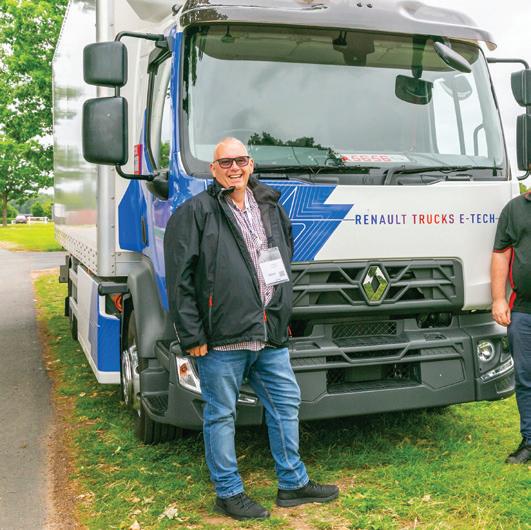


F But while sales are growing, they make up a tiny share of the market. And the SMMT argues that with only one public HGV chargepoint in the UK, a national plan for public and depot infrastructure is urgently needed.
In October, the government announced a £200 million boost to decarbonise freight vehicleswhich includes demonstrators programmes and the delivery of 57 charging and refuelling sites.
One future technology that could significantly help future electric trucks is wireless charging.
Researchers at Chalmers University of Technology in Sweden have pushed inductive power transfer technology further to enable high-power battery charging for the fleet industry.
The wireless charger uses a new type of silicon carbide semiconductor and a newly developed copper wire that is as thin as a human hair. These two factors make transmitting high power through air a realistic proposition.
Charging power of 150kW to 500kW would be possible without a physical connection between the vehicle and charger. This makes charging at a depot, for example, more straightforward and removes the need for heavy charging cable.
There are a handful of electric trucks now on the market. One example is the Mercedes-Benz Trucks eActros 600, which is equipped with three battery packs providing a total capacity of 621kWh. The range is said to be around 300 miles, but Mercedes says it will be able to travel

Automated drones can navigate direct routes, avoiding traffic congestion, bypassing multiple stops and therefore reducing delivery times
“significantly” more than 600 miles per day by intermediate charging during legally prescribed driver breaks.
There are examples of fleets successfully using electric trucks too. Amazon has five 37-tonne fully-electric vehicles operating from Amazon’s fulfilment centres in Tilbury and Milton Keynes, transporting customer packages with zero tailpipe emissions. And there’s innovation around hydrogen as a zero-emission fuel too. For example, Hydrogen Vehicle Systems (HVS) is a new UK-based hydrogen vehicle OEM which has unveiled its 40-tonne HGV technology demonstrator with a 370-mile range.
Meanwhile, IVECO has announced that it will produce fuel cell electric HGVs following the acquisition of the former joint venture Nikola Iveco Europe. The fuel cell vehicle is reported to have a range of just under 500 miles with fastrefuelling time of under 20 minutes.
Another future technology that could change the future of logistics is drones.
Automated drones can reduce transportation and human costs and increase the efficiency of deliveries.
Automated drones can navigate direct routes, avoiding traffic congestion, bypassing multiple stops and therefore reducing delivery times. Replacing or supplementing conventional transportation methods with battery-powered drones will also result in fewer delivery vehicles on the road, helping to reduce carbon emissions and air pollution.
Royal Mail and Skyports Drone Services are conducting a drone delivery project established in partnership with Orkney Islands Council Harbour Authority and Loganair.
This involves a daily inter-island mail distribution service between three islands on Orkney. The project will initially operate for three months, with the intent to extend in the future.
Letters and parcels will be transported from Royal Mail’s Kirkwall delivery office to E


F Stromness, from where Skyports Drone Services will conduct drone deliveries to Royal Mail staff on Graemsay and Hoy.
Royal Mail is also working with Windracers, to scale up its use of drone technology and create more than 50 new postal drone routes over the next three years, subject to Civil Aviation Authority (CAA) approval.
The partnership will facilitate and operate uncrewed drones to provide faster and more convenient services for customers in remote communities.

MaaS has the potential to help the UK meet its decarbonisation ambitions
Mobility as a service
Mobility as a Service (MaaS) is the integration of various modes of transport along with information and payment functions into a single mobility service. It can offer streamlined journeys for travellers and commuters; help achieve the UK’s environmental targets and make use of innovative technology to encourage modal shift.
MaaS has the potential to help the UK meet its decarbonisation ambitions by making sustainable transport options, such as shared mobility and public transport, an easy option. MaaS can help the travelling public make more sustainable choices by providing information on carbon emissions and enabling walking and cycling routes.
In late August, the government published its Mobility as a Service (MaaS) Code of Practice, which will be an important tool for local authorities looking to implement MaaS solutions.
Transport for West Midlands is working on a MaaS app to be released in 2024. It will provide residents and visitors with a digital one-stopshop for travel using public, active, and shared transport. As part of the programme, it will also integrate the systems used for customer service, accounts, passenger information, and transactions. L
In the ever-evolving landscape of commercial vehicles, the Isuzu D-Max continues to set the standard as the epitome of reliability, durability, and performance

As the pick-up professionals, Isuzu takes pride in crafting vehicles designed to go the distance, and the latest D-Max pick-up range is a testament to commitment in meeting diverse business needs.
The New-Look Isuzu D-Max, equipped with a robust turbo diesel engine, delivers an impressive 164PS and 360Nm of torque, meeting Euro 6D emissions standards. Boasting towing capabilities of 3.5 tonnes, a maximum payload of 1,205kg, and a fuel efficiency of up to 39.4mpg, the D-Max proves to be a formidable workhorse. Isuzu’s dedication to customer satisfaction is evident in each new model, backed by a 125,000 mile/five-year warranty and five years of UK and European roadside assistance.
The New-Look Isuzu D-Max pick-up range caters to diverse requirements with three distinct categories: Business, All-Purpose, and Adventure Ranges. In the Business Range, the Utility model is perfect for fleet use, offering single, extended, or double-cab body styles with features like wipe-clean vinyl floor covering, hard-wearing cloth upholstery, and automatic headlights and windscreen wipers. The All-Purpose Range introduces the DL20 with added features like heated front seats and rear parking sensors, while the DL40 enhances the experience with premium specifications such as keyless entry, pushbutton start, dual-zone climate control, leather interior, and advanced multimedia options.
The Adventure range’s V-Cross model stands out with a 9-inch multimedia system, an eight-speaker sound system, and distinctive gun-metal grey exterior styling elements.
The Isuzu Fleet Conversion Centre is a dedicated centre that specialises in pick-up conversions, livery, and fleet solutions, offering a comprehensive build-to-order service while retaining the manufacturer warranty. With a 32-acre site housing five workshops, Isuzu’s fully trained technicians have the expertise to carry out a wide range of conversions to tailor the D-Max range to individual needs. Mark Hayes, Isuzu fleet sales manager says, “By directly providing tailored solutions and being CCS accredited, our commitment to excellence ensures that our fleet customers have all the support they need from one supplier.” L
FURTHER INFORMATION
To discover more about the Isuzu D-Max fleet experience and the innovative Fleet Conversion Centre, visit https://www.isuzu.co.uk/fleet

‘One’
0344


ECOGRIT
0800 193 6466
gaz@ecogrit.co.uk

ecogrit.co.uk
EcoGrit supplies a granular deicer which is safe to use around plants, children and animals. It is effective to below -20C and isn’t corrosive like rock salt. EcoGrit Concentrate is used by emergency services, wildlife trusts, English Heritage, National Trust, vets, councils and maintenance contractors to name just a few.
CUBIC APPLE
01827 713870/ 07973 218790
tm44@cubicapple.co.uk


www.cubicapple.co.uk
Cubic Apple have been undertaking independent TM44 Air Conditioning Inspections since 2010. TM44 Inspections are a mandatory legal requirement for all buildings with a combined cooling output from 12kW>. TM44 AC Inspections can only be completed by an accredited energy assessor. Cubic Apple undertake TM44 Inspections throughout the UK.
TRIDENT FIRE COMPLIANCE
www.tridentcompliance.co.uk/contact-us
enquiries@tridentcompliance.co.uk

www.tridentcompliance.co.uk
Trident Fire Compliance are a fully independent and impartial consultancy specialising in the field of passive fire protection and fire safety in both new and existing buildings across the UK. Our services include passive fire protection consultations, specifications & inspections, compartmentation surveys, and fire risk assessments.
© 2024 Public Sector Information Limited. No part of this publication can be reproduced, stored in a retrieval system or transmitted in any form or by any other means (electronic, mechanical, photocopying, recording or otherwise) without the prior written permission of the publisher. Whilst every care has been taken to ensure the accuracy of the editorial content the publisher cannot be held responsible for errors or omissions. The views expressed are not necessarily those of the publisher. ISSN 1470-0735
Government Business is a member of the Independent Press Standards Organisation (which regulates the UK’s magazine and newspaper industry). We abide by the Editors’ Code of Practice and are committed to upholding the highest standards of journalism. If you think that we have not met those standards and want to make a complaint please contact Polly Jones or Angela Pisanu on 0208 532 0055. If we are unable to resolve your complaint, or if you would like more information about IPSO or the Editors’ Code, contact IPSO on 0300 123 2220 or visit www.ipso.co.uk


We’re an award-winning global sustainability consultancy, helping clients unlock sustainable value to transition to a lower carbon economy.
We provide strategic guidance, compliance support and innovative Real Estate solutions:
Sustainability Strategy and Design Data and Green Certification Building Optimisation Policy and Regulations
Climate Resilience Renewable energy
Our end-to-end bespoke services can help you achieve your energy and resource efficiency targets.







Discover Isuzu UK’s Fleet Conversion Centre. Our renowned team provides a tailored one-stop-shop vehicle production service, minimising downtime and guaranteeing optimal vehicle performance, safety, and Isuzu vehicle warranty preservation.
Experience the unrivalled New-Look Isuzu D-Max, winner of the prestigious Fleet News ‘Best all-terrain Workhorse award for two consecutive years. Learn why it is the ultimate choice for your fleet at isuzu.co.uk/fleet